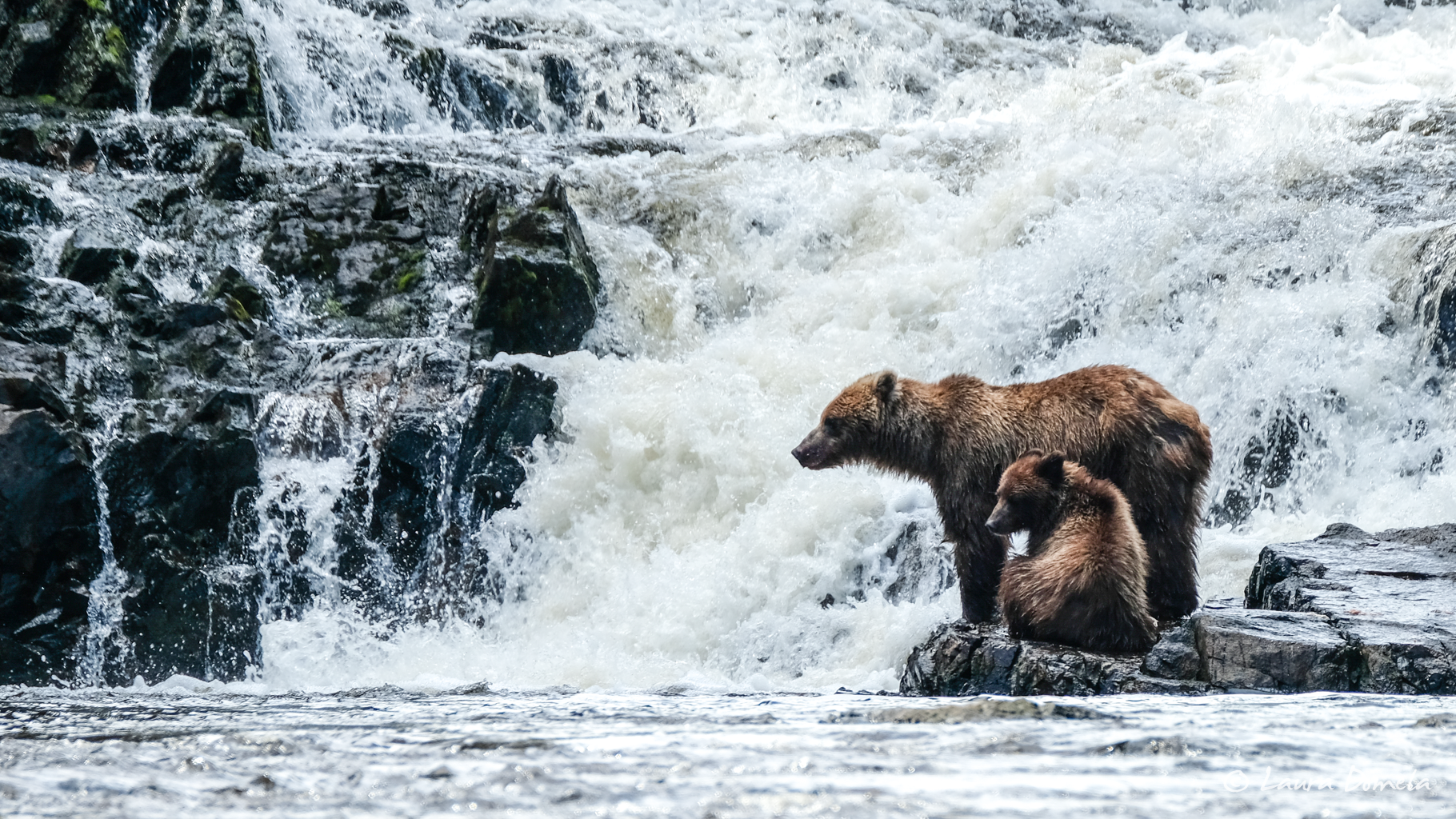Recently, I was reading through John Muir’s notes on his trips to SE Alaska in 1879, 1880, and 1889, and came across the part of his 1880 visit where they went up what is now called Endicott Arm, and into what is now called Ford’s Terror. He didn’t have to call it by name….I knew exactly where they were.
“After we had sailed about three miles up this side fiord, we came to what seemed to be its head, for trees and rocks swept in a curve around from one side to the other without showing any opening, although the walls of the cañon were seen extending back indefinitely, one majestic brow beyond the other.
When we were tracing this curve, however, in a leisurely way, in search of a good landing, we were startled by Captain Tyeen shouting, “Skookum chuck! Skookum chuck!” (strong water, strong water), and found our canoe was being swept sideways by a powerful current, the roar of which we had mistaken for a waterfall. We barely escaped being carried over a rocky bar on the boiling flood, which, as we afterwards learned, would have been only a happy shove on our way. After we had made a landing a little distance back from the brow of the bar, we climbed the highest rock near the shore to seek a view of the channel beyond the inflowing tide rapids, to find out whether or no we could safely venture in. Up over rolling, mossy, bushy, burnished rock waves we scrambled for an hour or two, which resulted in a fair view of the deep-blue waters of the fiord stretching on and on along the feet of the most majestic Yosemite rocks we had yet seen. This determined our plan of shooting the rapids and exploring it to its farthest recesses. This novel interruption of the channel is a bar of exceedingly hard resisting granite, over which the great glacier that once occupied it swept, without degrading it to the general level, and over which tide-waters now rush in and out with the violence of a mountain torrent.
Returning to the canoe, we pushed off, and in a few moments were racing over the bar with lightning speed through hurrahing waves and eddies and sheets of foam, our little shell of a boat tossing lightly as a bubble. Then, rowing across a belt of back-flowing water, we found ourselves on a smooth mirror reach between granite walls of the very wildest and most exciting description, surpassing in some ways those of the far-famed Yosemite Valley.
Gliding on and on, the scenery seemed at every turn to become more lavishly fruitful in forms as well as more sublime in dimensions–snowy falls booming in splendid dress; colossal domes and battle meets and sculptured arches of a fine neutral-gray tint, their bases raved by the blue fiord water; green ferny dells; bits of flower-bloom on ledges; fringes of willow and birch; and glaciers above all. But when we approached the base of a majestic rock like the Yosemite Half Dome at the head of the fiord, where two short branches put out, and came in sight of another glacier of the first order sending off bergs, our joy was complete. I had a most glorious view of it, sweeping in grand majesty from high mountain fountains, swaying around one mighty bastion after another, until it fell into the fiord in shattered overleaning fragments. When we had feasted awhile on this unhoped-for treasure, I directed the Indians to pull to the head of the left fork of the fiord, where we found a large cascade with a volume of water great enough to be called a river, doubtless the outlet of a receding glacier not in sight from the fiord.”
More from John Muir’s notes from his 1880 visit to this area can be found here.
We had no solid plans to return to Ford’s Terror again this summer, but after reading the enthusiastic account of Muir’s first experience of the place, we decided to make one more trip in.
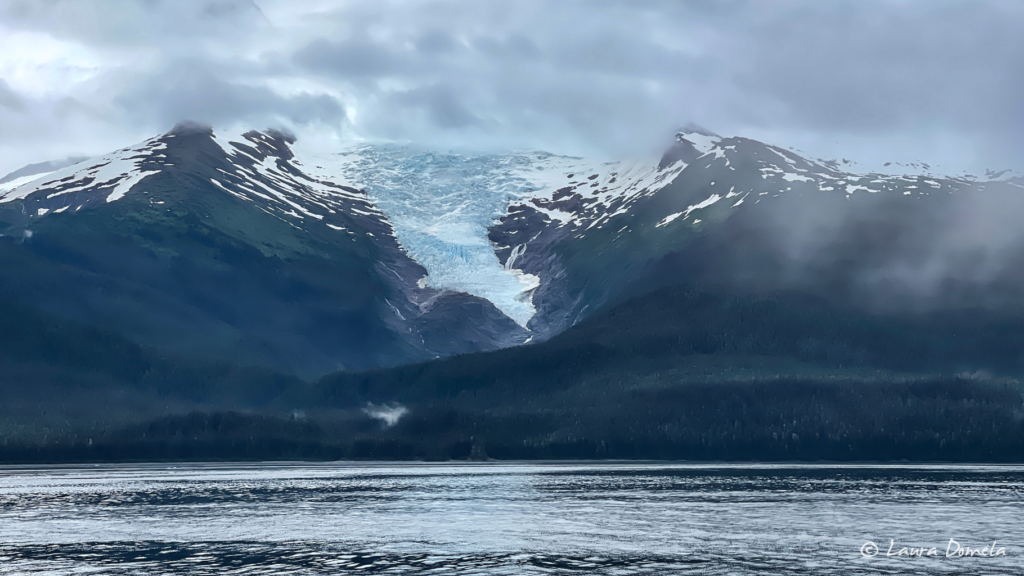
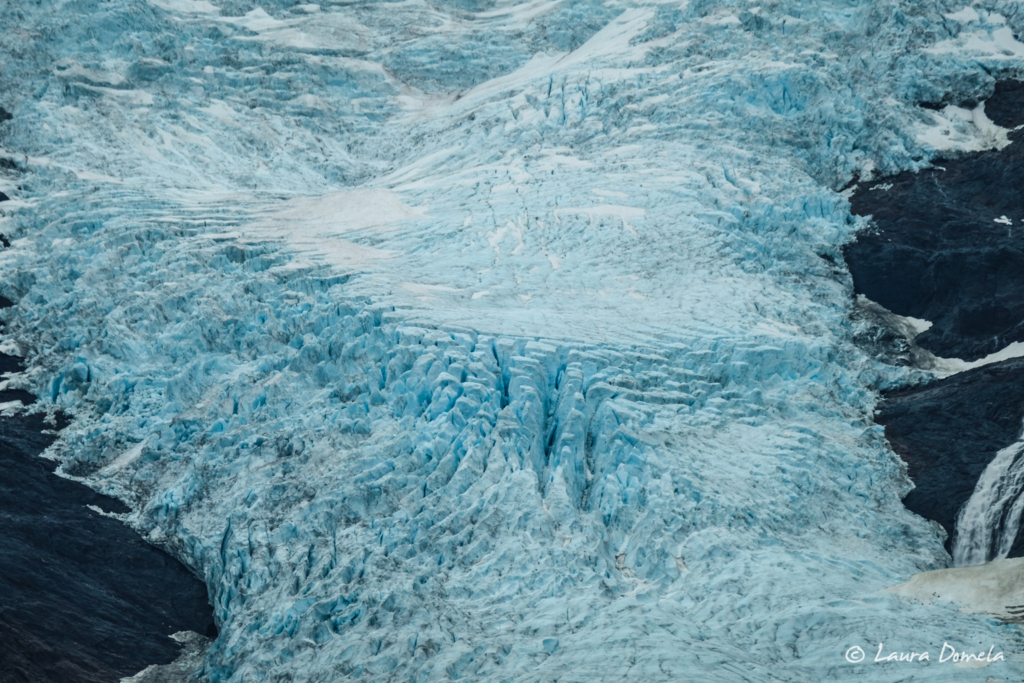
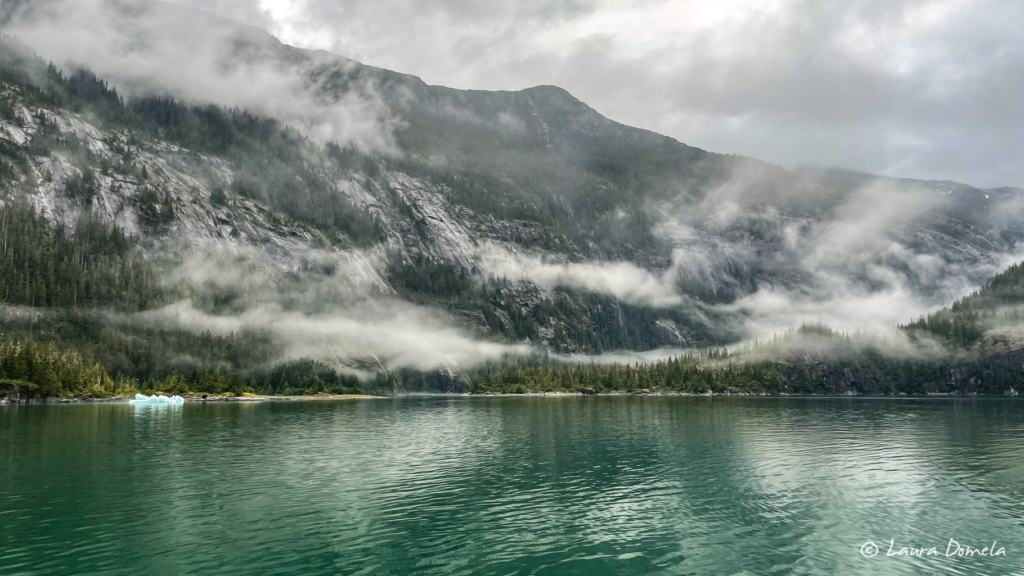
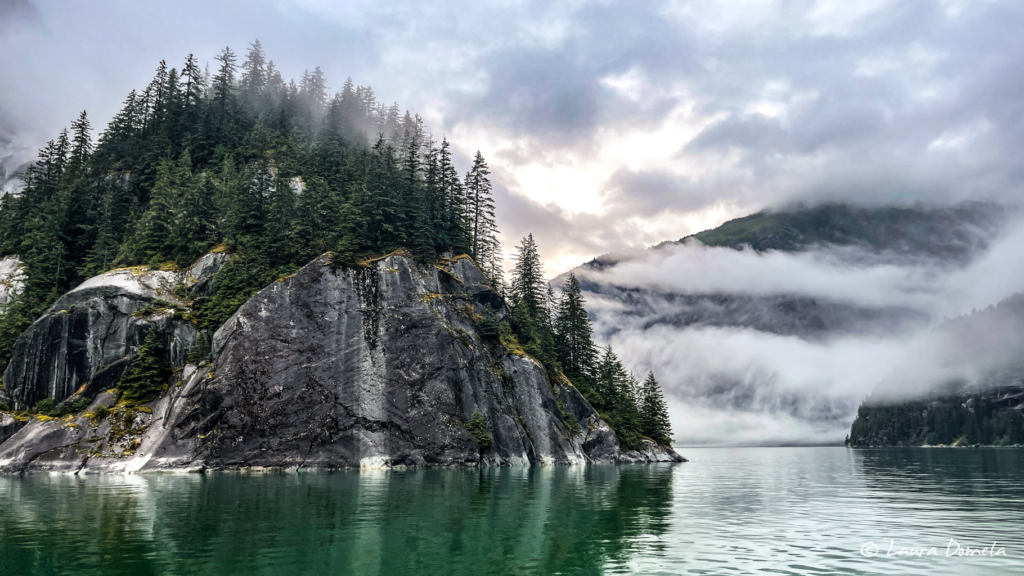
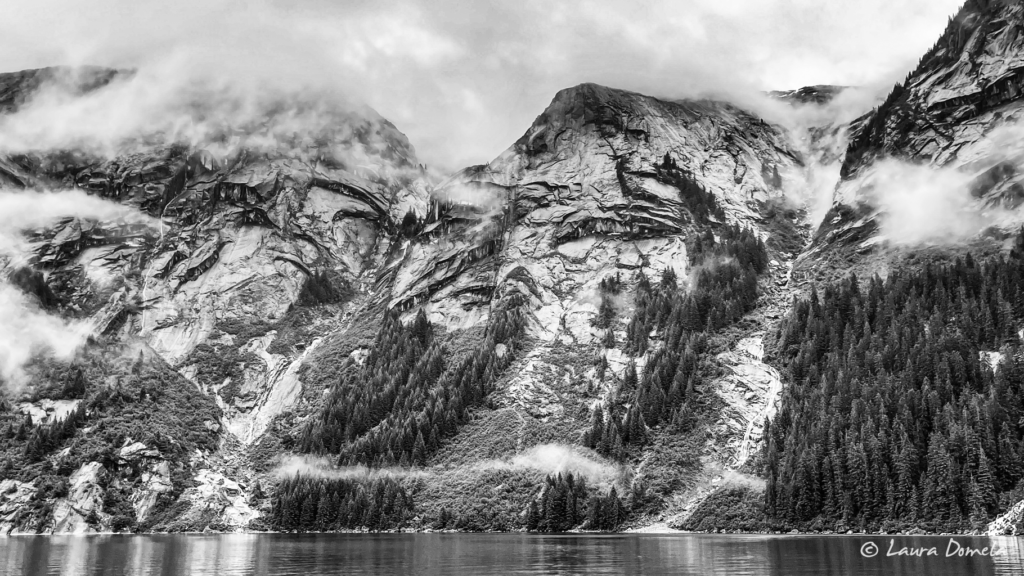
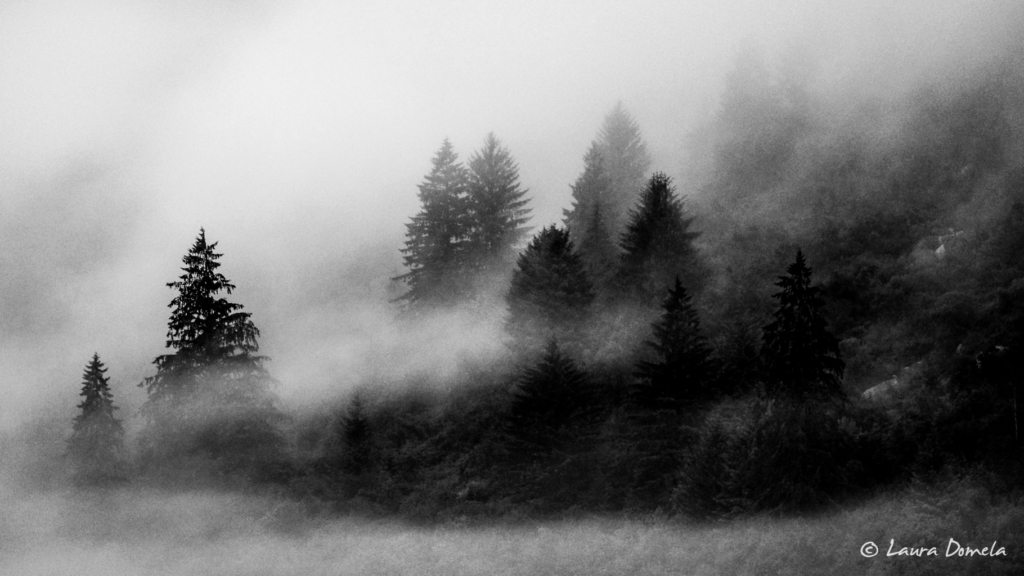
We left Juneau around 10:30am and went all the way to Ford’s Terror to catch the 8pm high slack (about 60nm, so a long day). There was only one other boat in the anchorage (a cool 1924 vessel called Westward, that came in with us), and the weather was soft, drizzly, and gray.
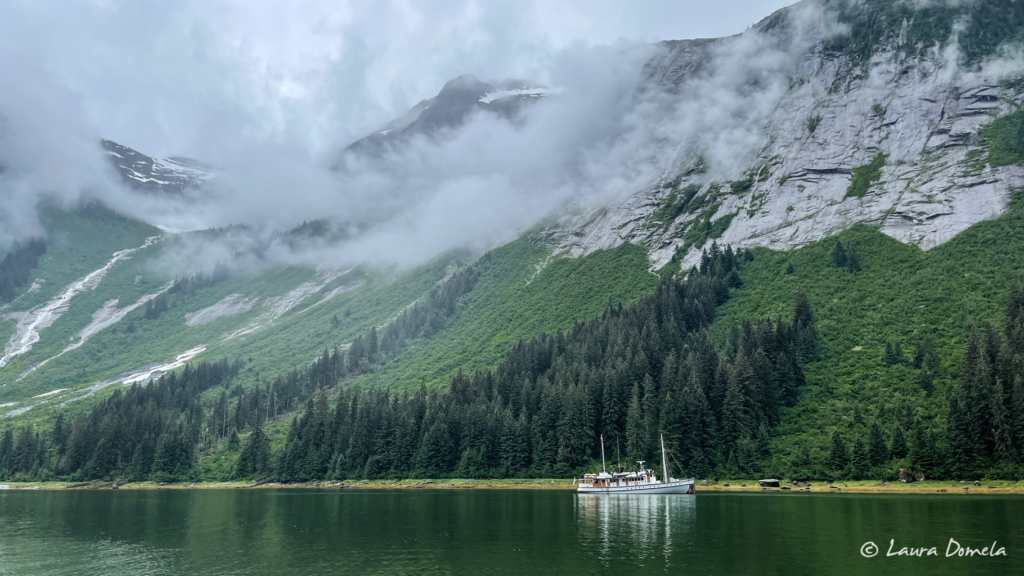
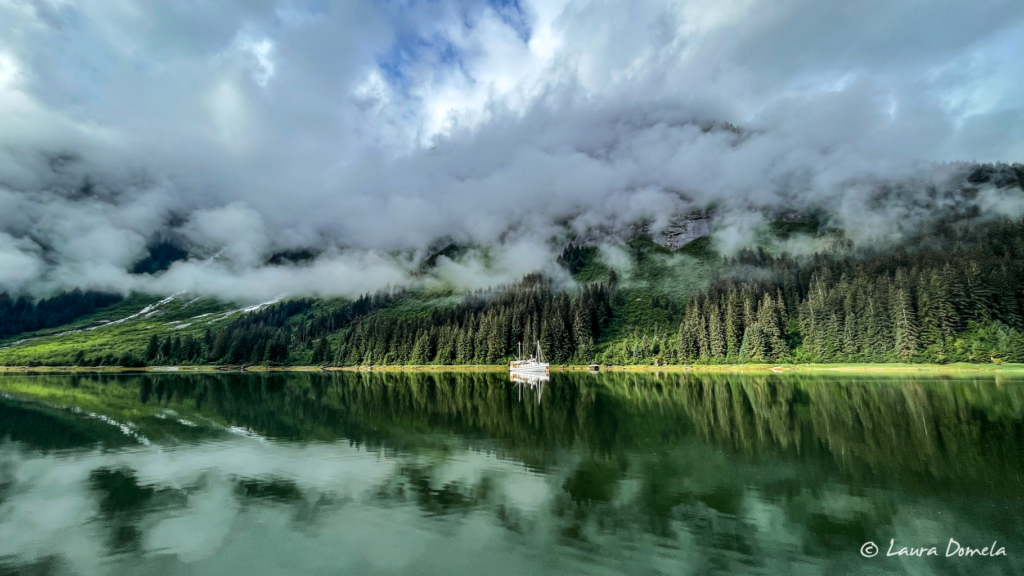
We put out two prawn traps from Airship on our way in, and when we pulled them in the morning we had about three dozen prawns in each trap.
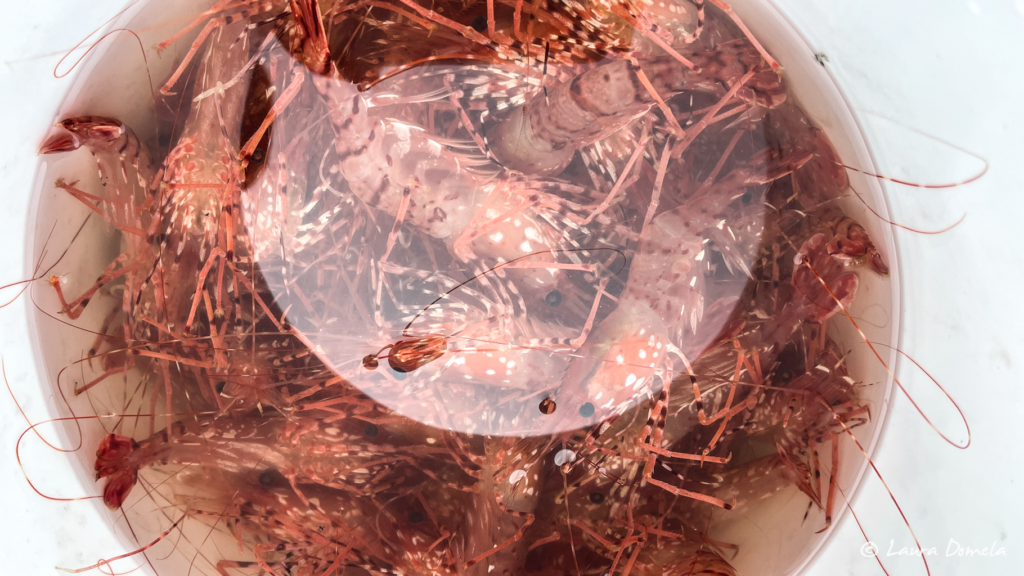
This trend repeated itself during our stay until we had roughly 250 prawns all told, some of which we ate, and the rest we froze for future use. I also made some prawn stock, slow cooking the heads in water for four hours, which turned our usually delicious prawn risotto into a much richer, more delicious version of itself.
The next day Westward left and we had the place to ourselves, which is both awesome and eerie. It’s no wonder Muir initially named this place “Yosemite Bay”. (It wasn’t until about ten years later it got its current name, when the man named Ford found himself unable to exit due to the intense rapids at the narrow entrance.)
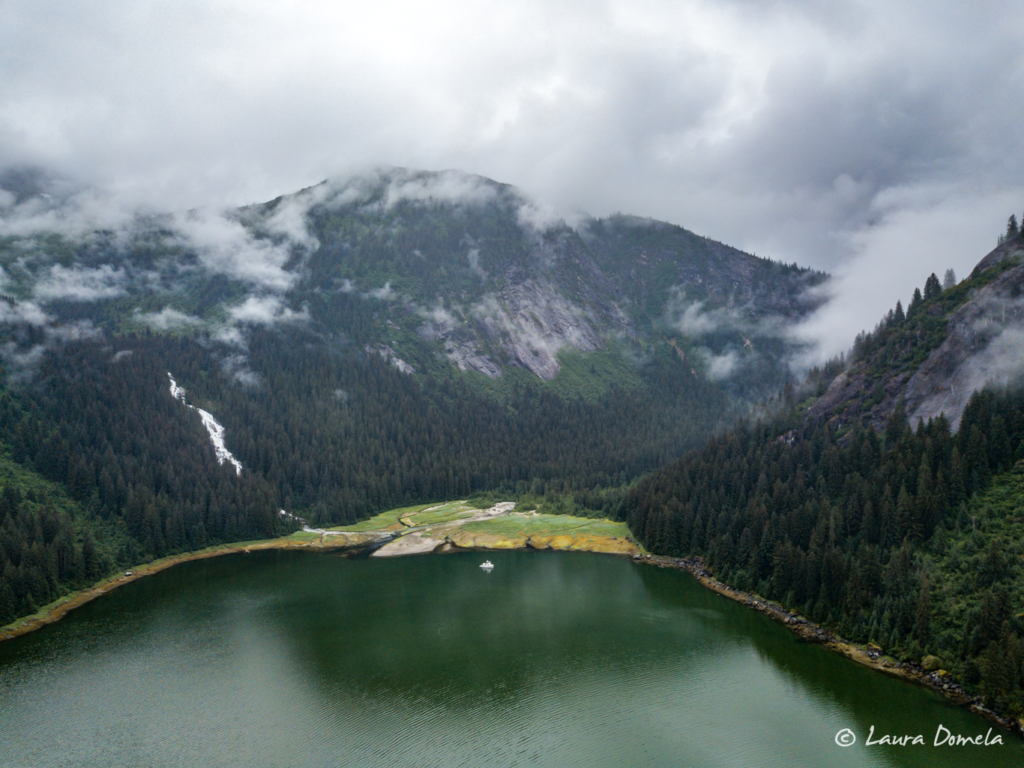
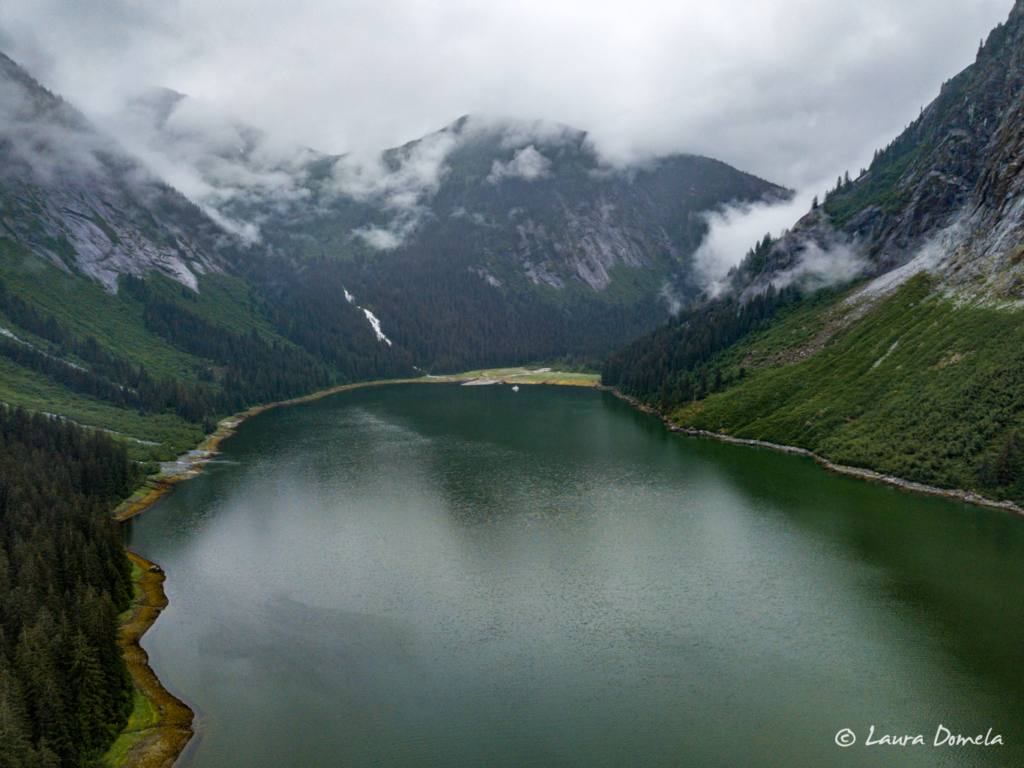
The next night, our friends Carol and Parker came in on their Kadey Krogen, Togo, along with a couple buddy boaters and one other boat we didn’t know but then got to know as they asked for some help with their anchor trying to set in the deep fjord. We did some dinghy exploring during the day, watched brown bears and harbor porpoises and seals, and enjoyed quiet evenings aboard.
After three nights, we left Ford’s Terror to make a noon high slack at the exit, and decided to go all the way into Juneau on Saturday because of Sunday’s weather forecast for Stephens Passage (20kts gusting to 35kts, waves 5ft). We were late into Juneau (8pm) and no transient moorage was open. We’d seen our friends on Alaska Quest on AIS earlier and texted asking about space as they could see it, and they were away but texted back and told us to side-tie to Alaska Quest if we didn’t find room, which we gladly took them up on. They returned later in the evening and we caught up a little and traded some crab for some prawns. We ended up staying tied to them the following day because it was just so crappy out and moving seemed a chore (and we were good neighbors and gave them homemade hot sauce and didn’t even leave the boat so no wet footprints in their cockpit). (Note, if you don’t have your own boat and want an intimate Alaska wilderness experience, Tom and Tish do a great job taking folks to all the best spots up here. You can find them here.)
We left downtown Juneau on Monday morning and headed around to Auke Bay for a night to see some friends and do some provisioning.
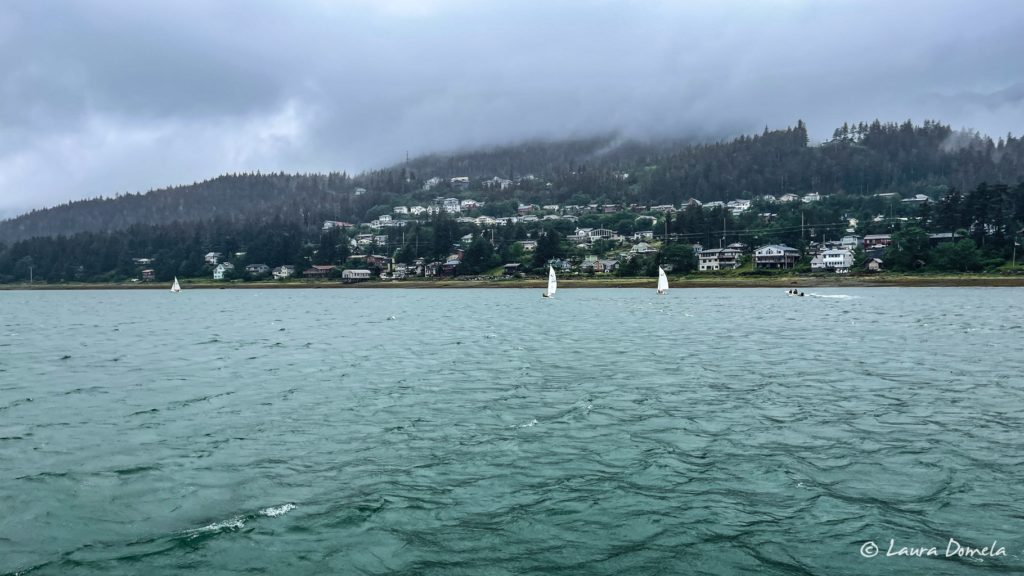
The next morning we left Auke Bay for Coot Cove in Funter Bay. We fished a bit for coho In the afternoon, and had several good bites but didn’t manage to get any on the boat. We did watch a humpback breaching in the distance though, so that was some consolation. On Wednesday we went down to Pavlof Bay on Chichagof Island. Saw quite a few humpbacks along the way, and it turned out to be a beautiful sunny calm day on the water in Chatham Strait.
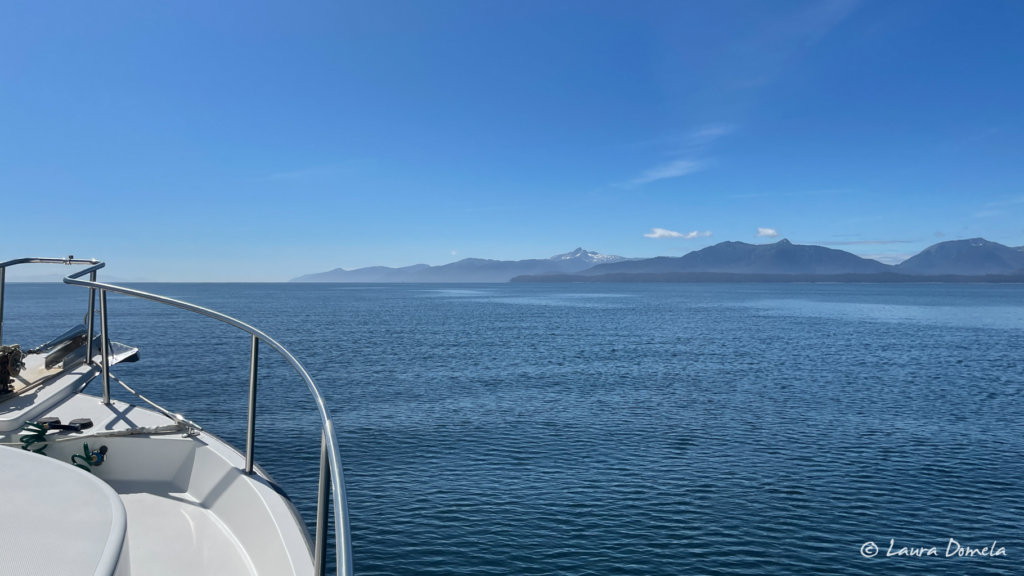
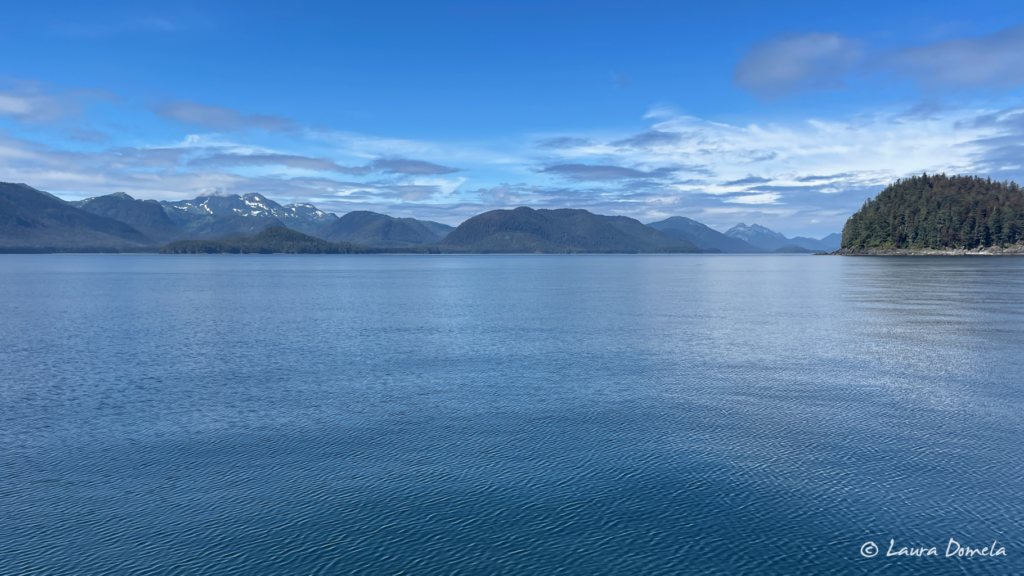
We anchored in Pavlof Harbor and we could see at least one brown bear by the waterfall from our boat, so we launched the dinghy and went for a closer view. There was a sow and cub, and mama was fishing at the base of the waterfall. The mama bear pretty quickly caught a fish and the cub came running.
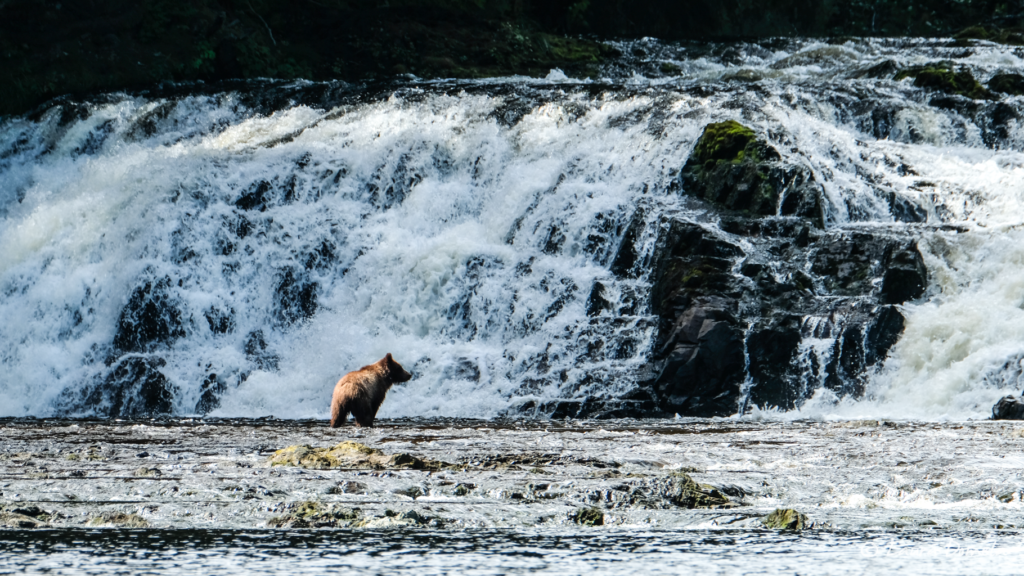
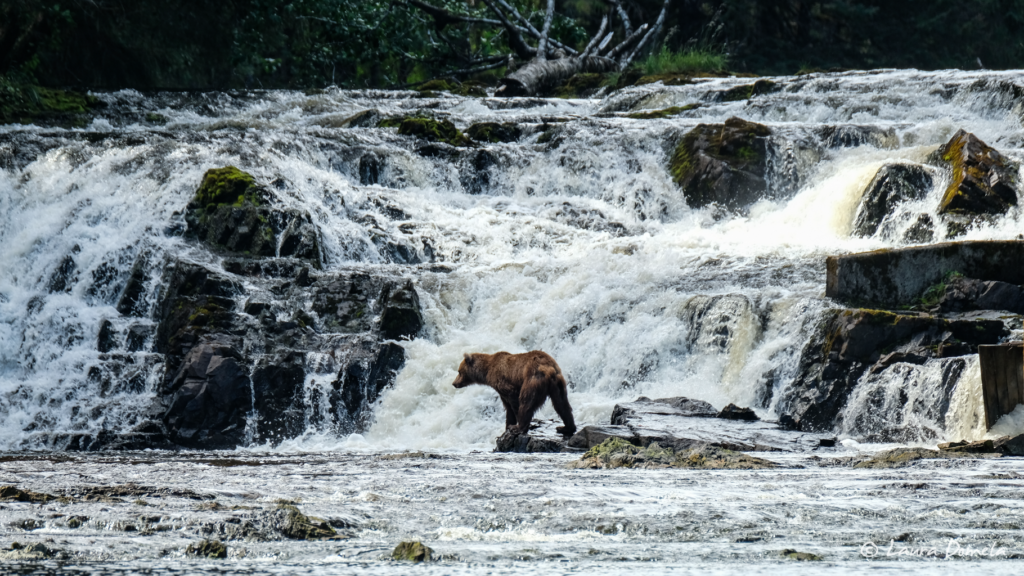
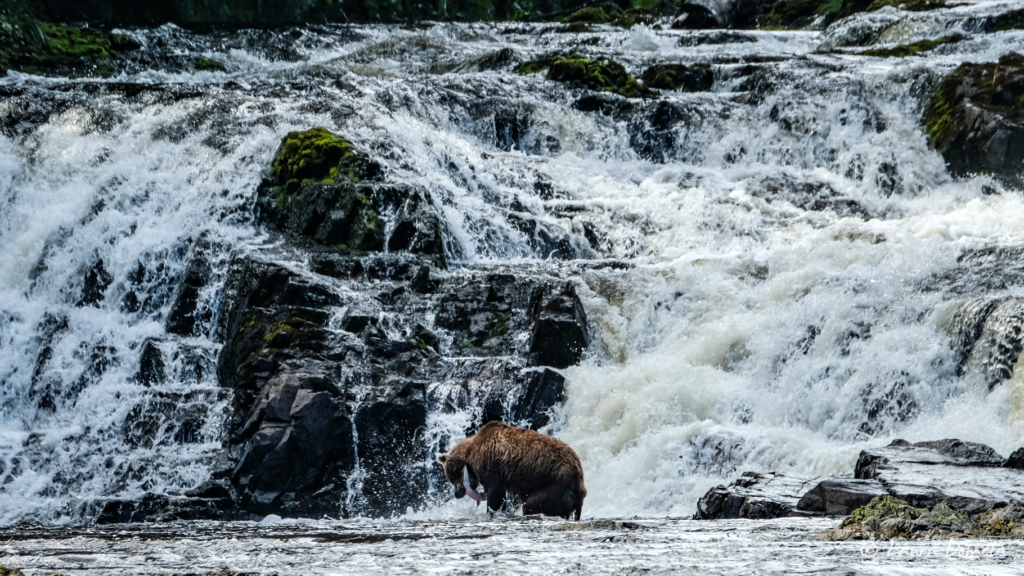
The two bears sat on the rock for a while after sharing the fish (and after a few reprimands from mama to cub about manners, or something like that).
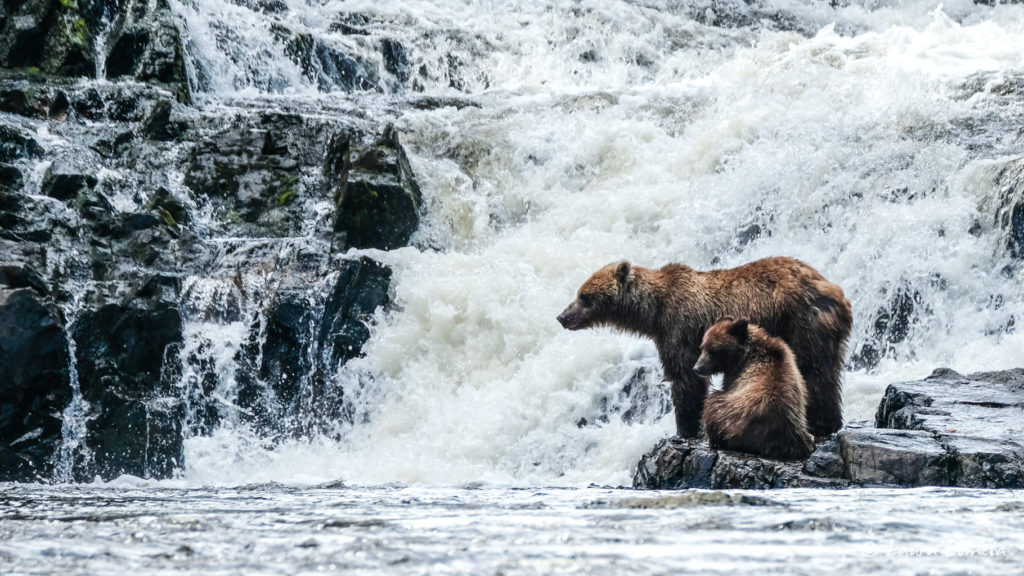
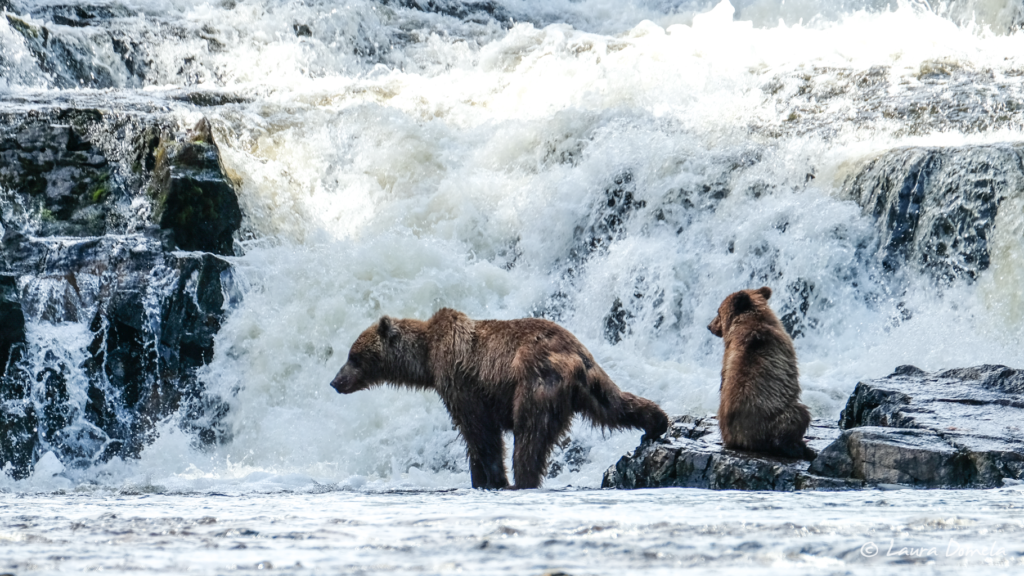
The mama climbed up to the edge of the fish ladder and scanned for more fish, but finding none, they moved on into the woods, right past two groups of bear watchers on shore.
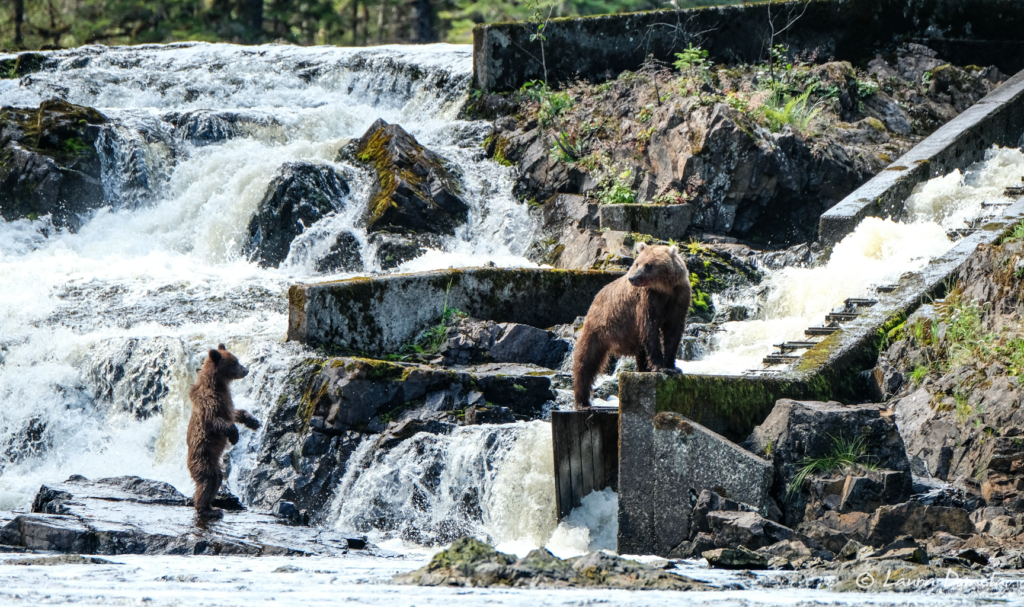
No sooner had they gone into the woods when further down the shore, a single male emerged from the grass and was making his way right along the beach toward the waterfall, which meant he was coming from behind the group of bear watchers, and his path would take him RIGHT through them. Sure enough, he saw (smelled) the humans, stopped and turned around to go uphill a little bit, but only altered course slightly. As he again approached the group of humans, the bear stopped and sniffed, the humans remained calm and talked to the bear (hand on bear spray can), and pretty soon the bear ambled on his way, passing with less than ten feet between him and the humans. Luckily, I had my camera ready and captured the holy $#*@ing sh$t moment for them. 🙂 (We met up with the group later on and it turns out all but two or three of them were professional bear watchers — guides for different companies, so they had practice at remaining calm.) Here’s how it played out in photos:
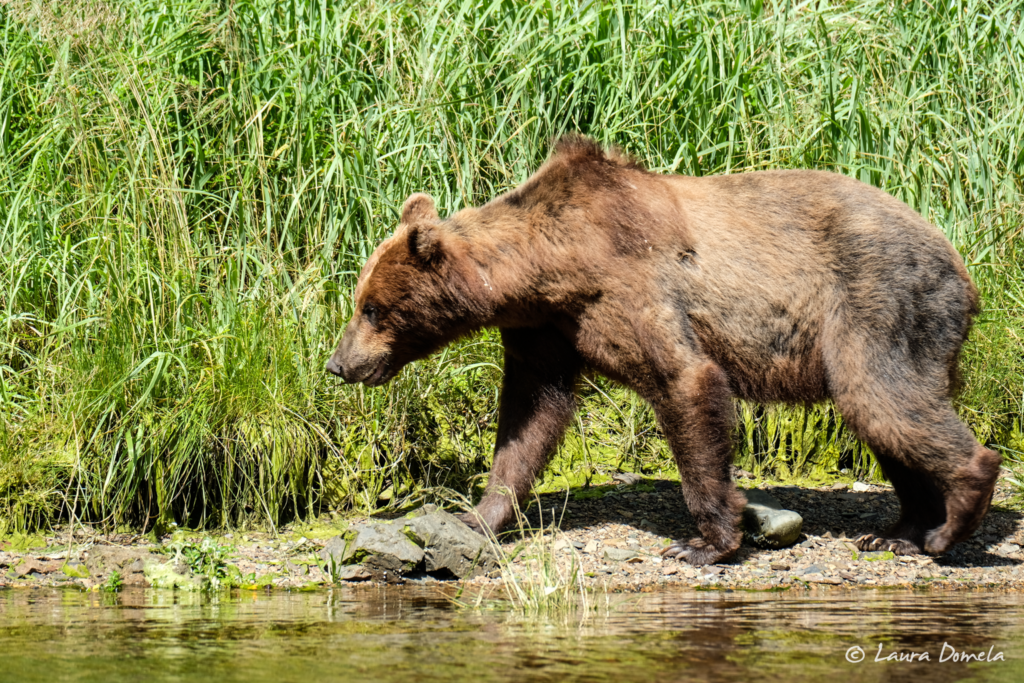
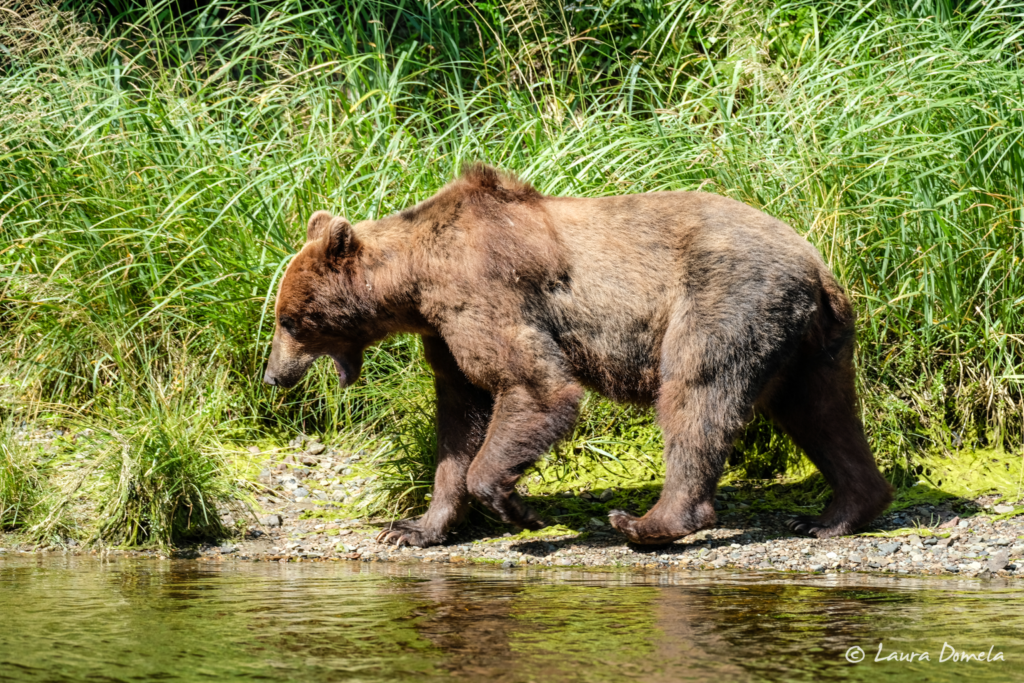
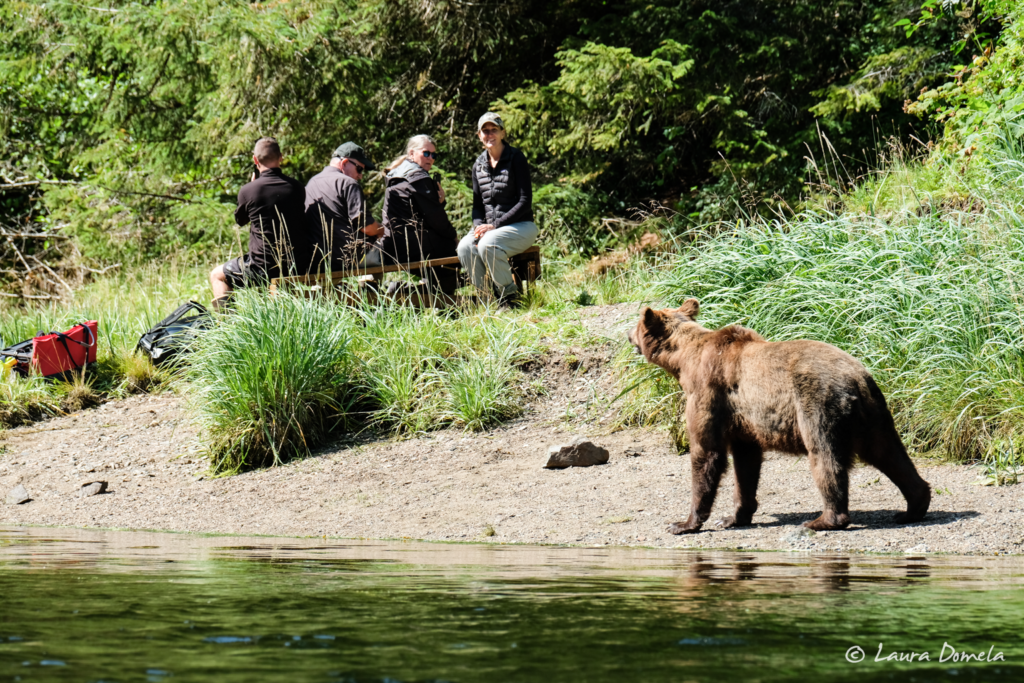
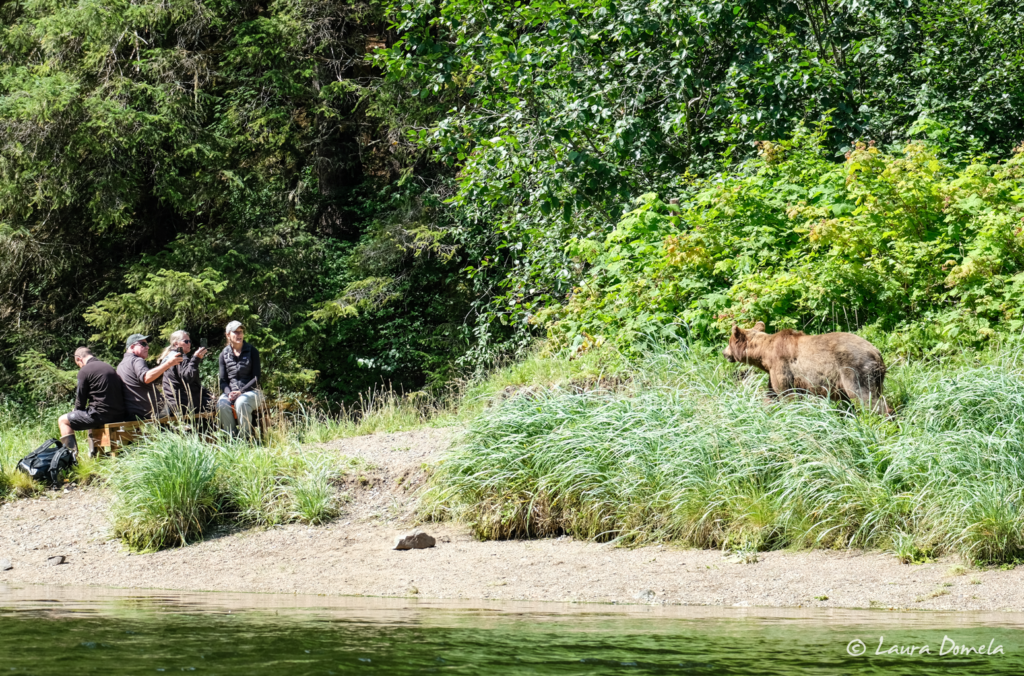
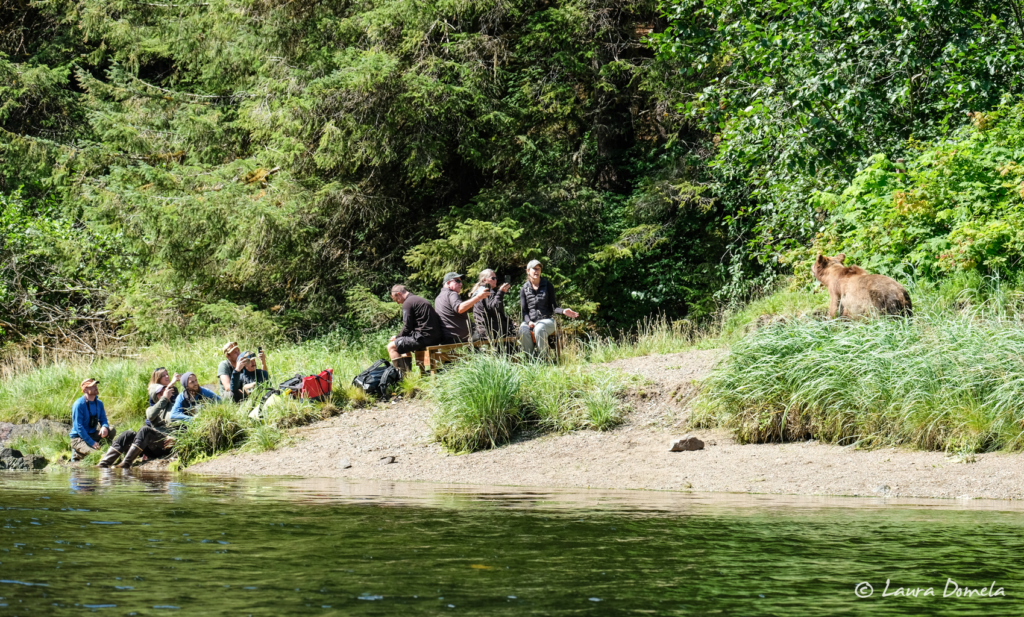
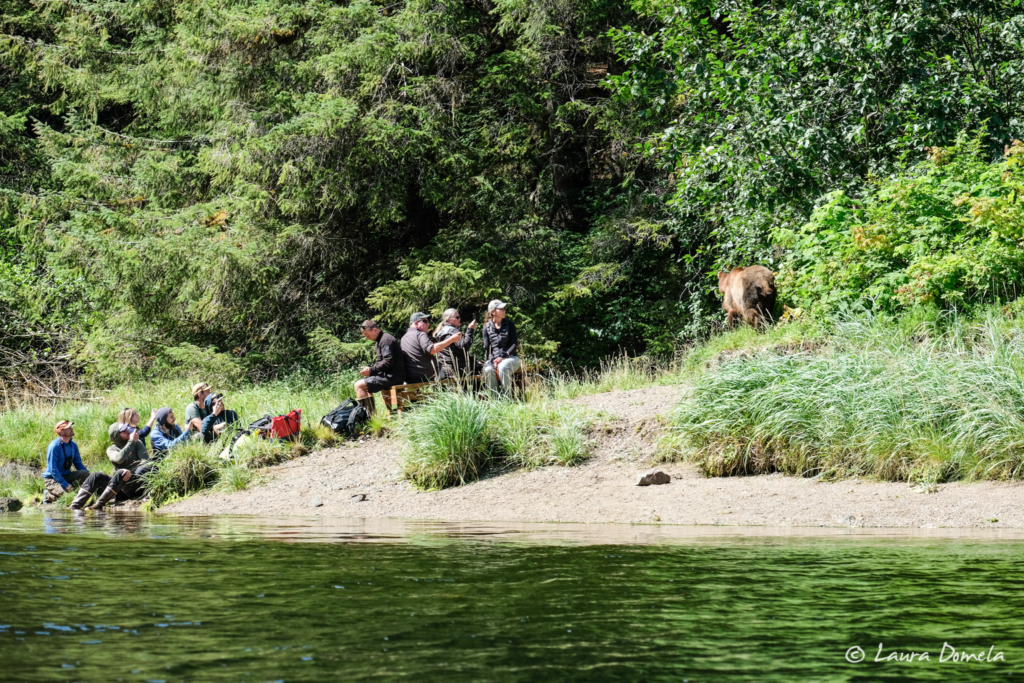
In this case, for once, the wildlife really IS as close as it looks in the pictures!
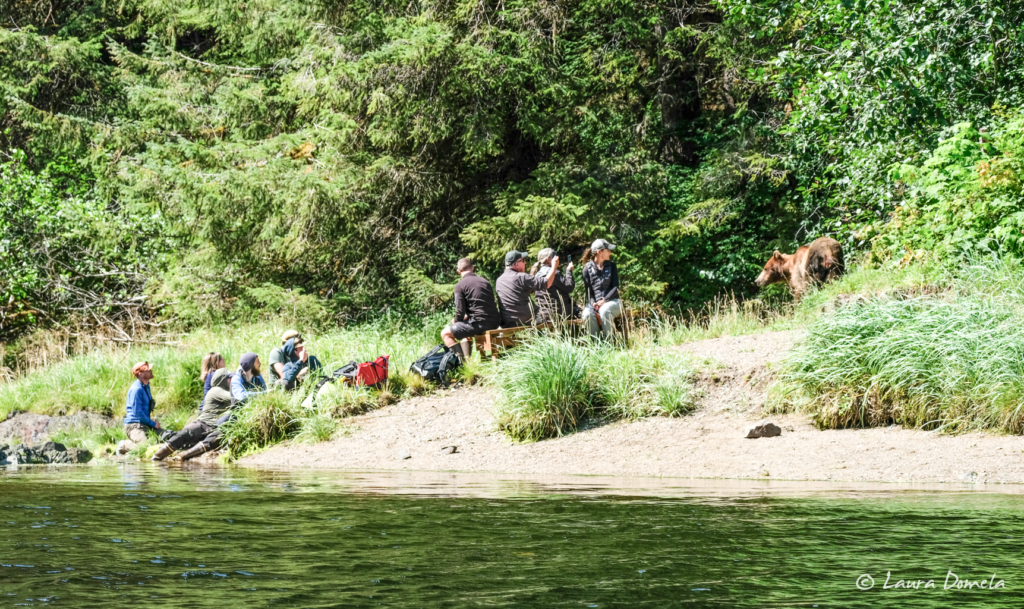
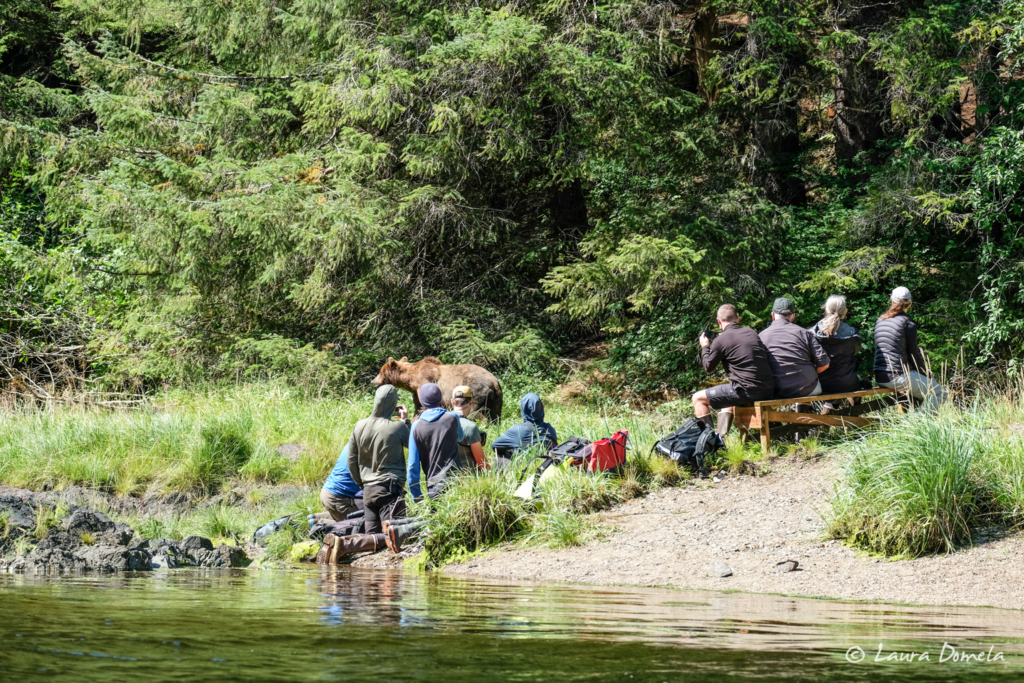
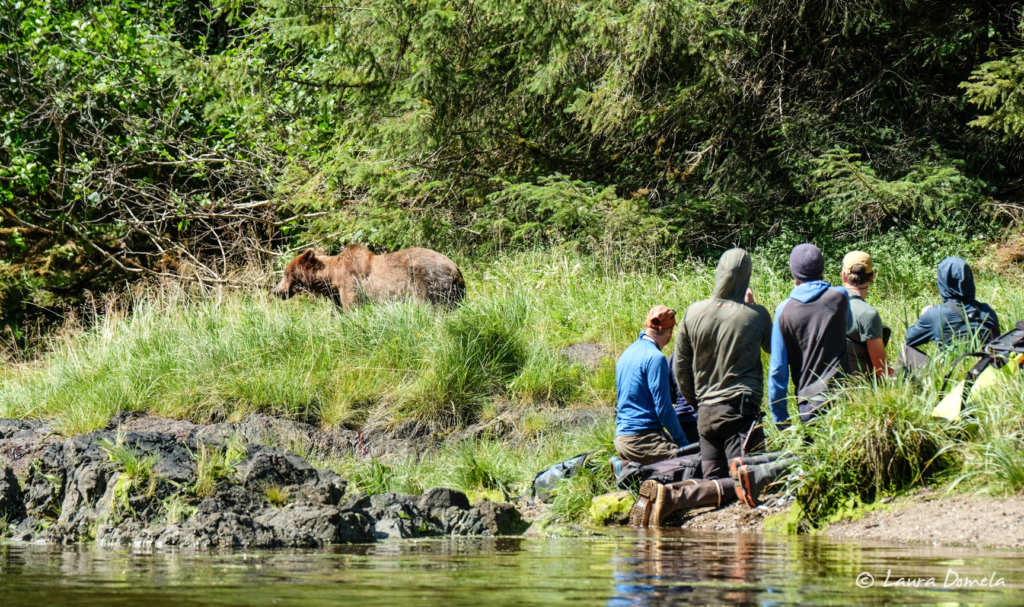
After the exciting bear activity, we went out and fished for a while (caught two pink salmon, which we’ll use as bait for more crab and perhaps halibut), then went back to the waterfall to watch bears again. On our way into the cove, we saw a woman from one of the neighboring boats watching the sow and cub onshore and snapped a couple photos to send her later.
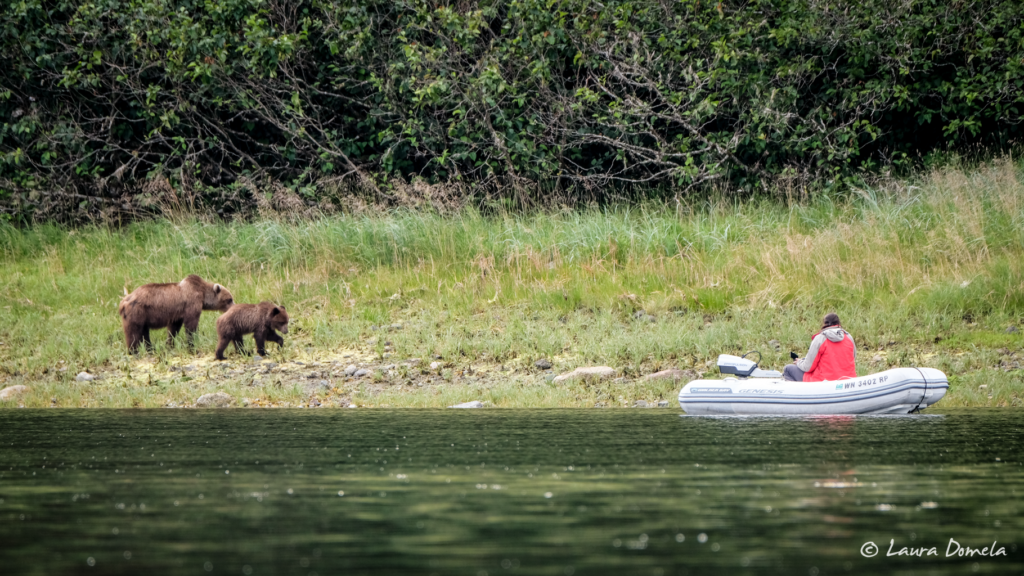
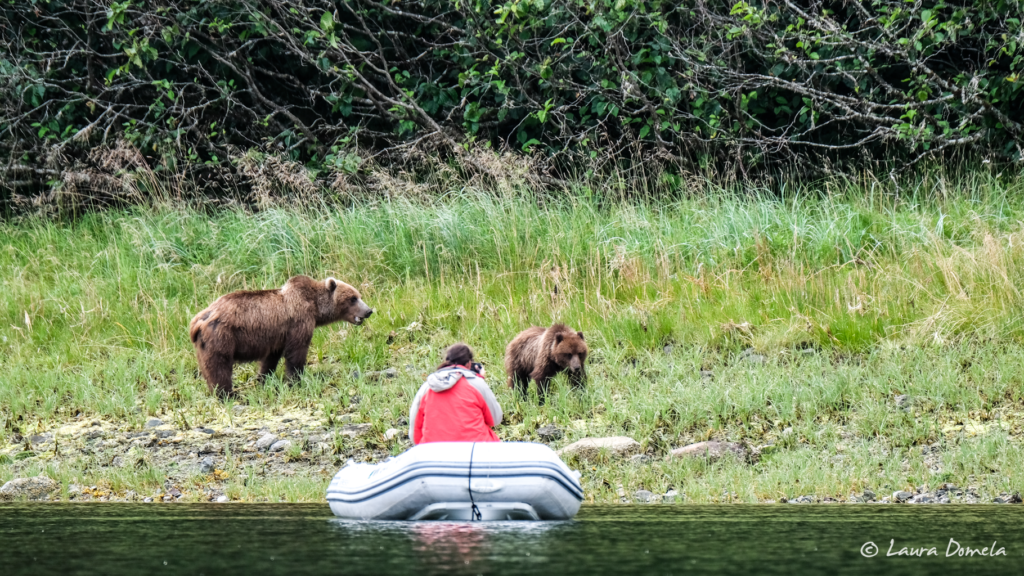
We headed into the waterfall and watched the male up at the top left of the falls for a bit, then pretty soon the sow and cub returned from the woods on the right. The little cub was VERY uncomfortable about the presence of the male bear, and either stuck super close to his mama, or climbed up as high as he could away from the male. The male eventually crossed the stream as mama kept an eye on him (and baby kinda freaked out climbing and running across the falls, standing on his back legs, and just generally looking extremely nervous. (I know, SO many photos!)
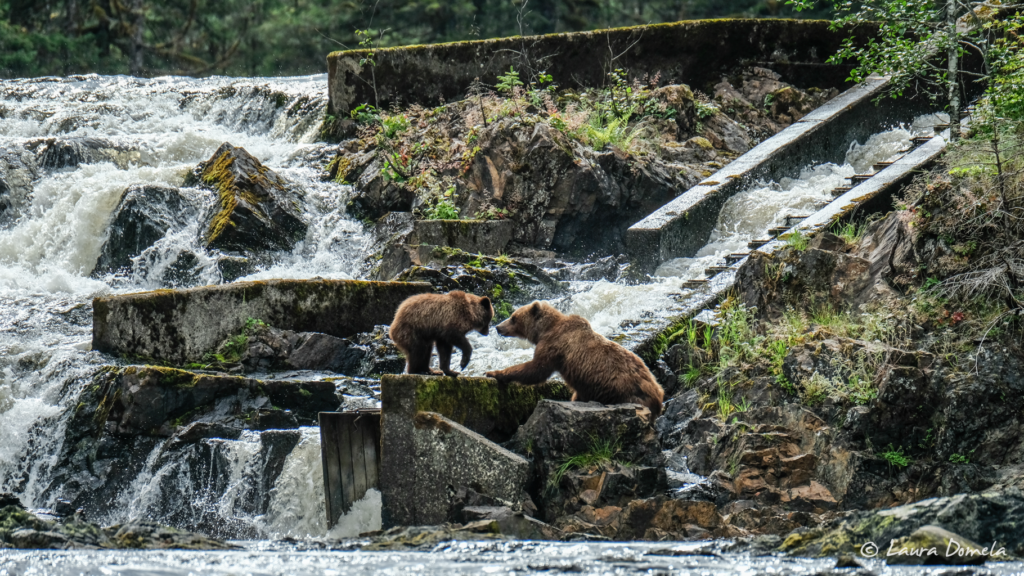
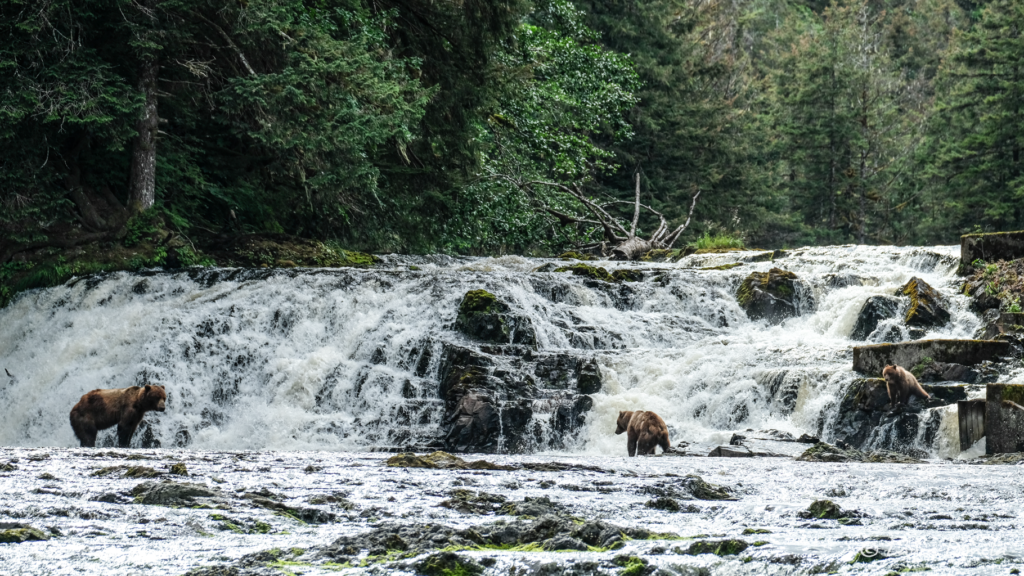
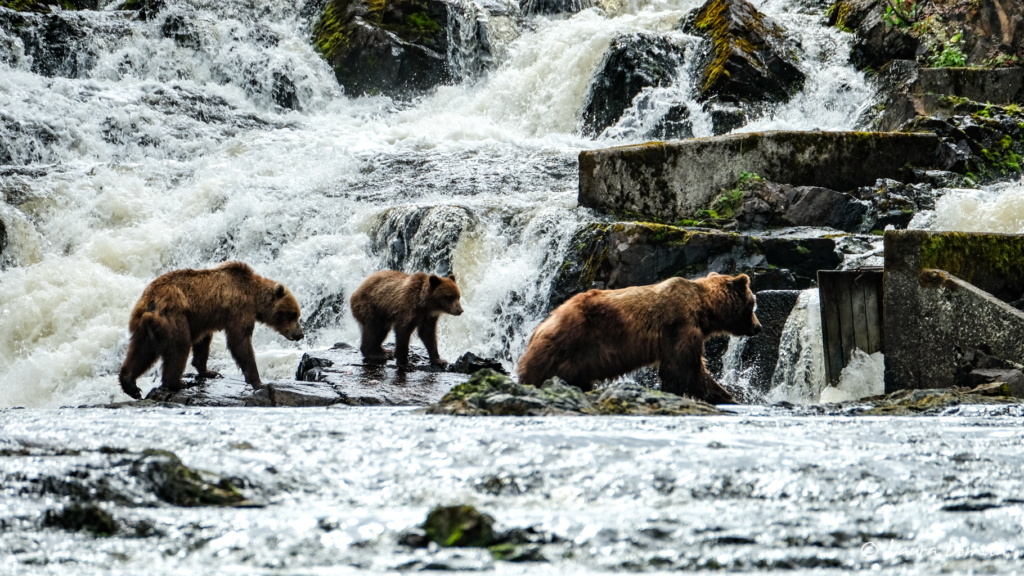
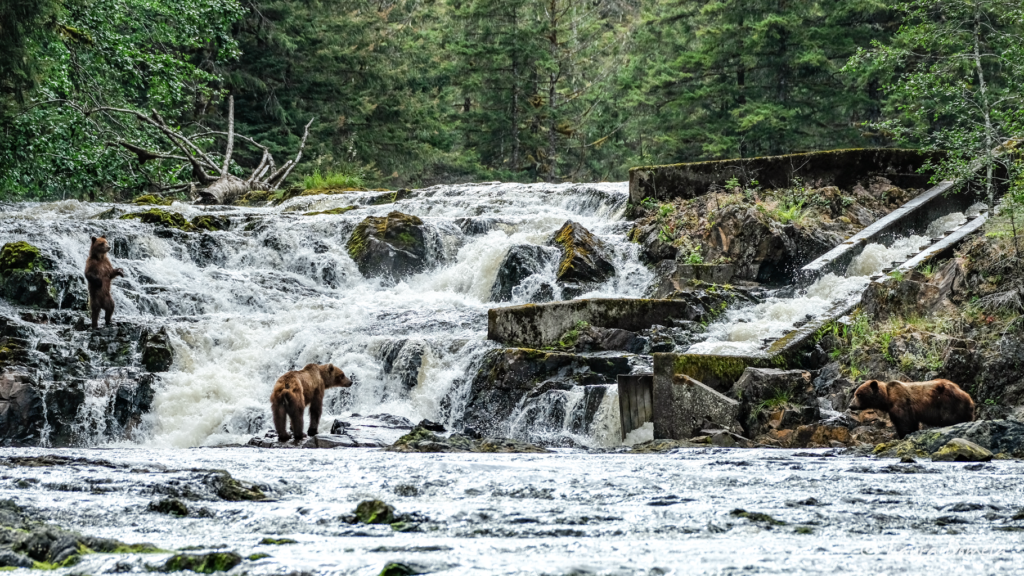
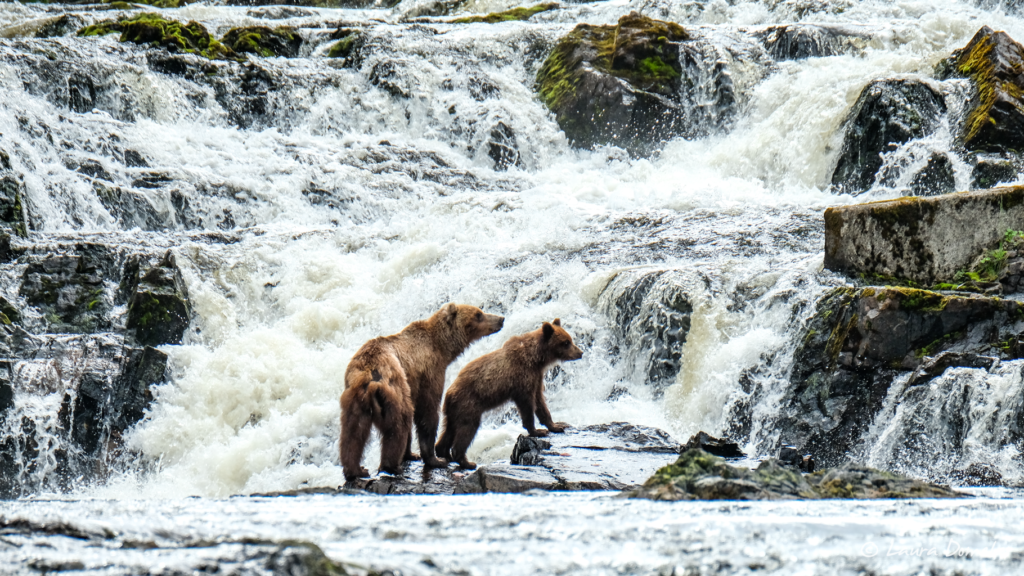
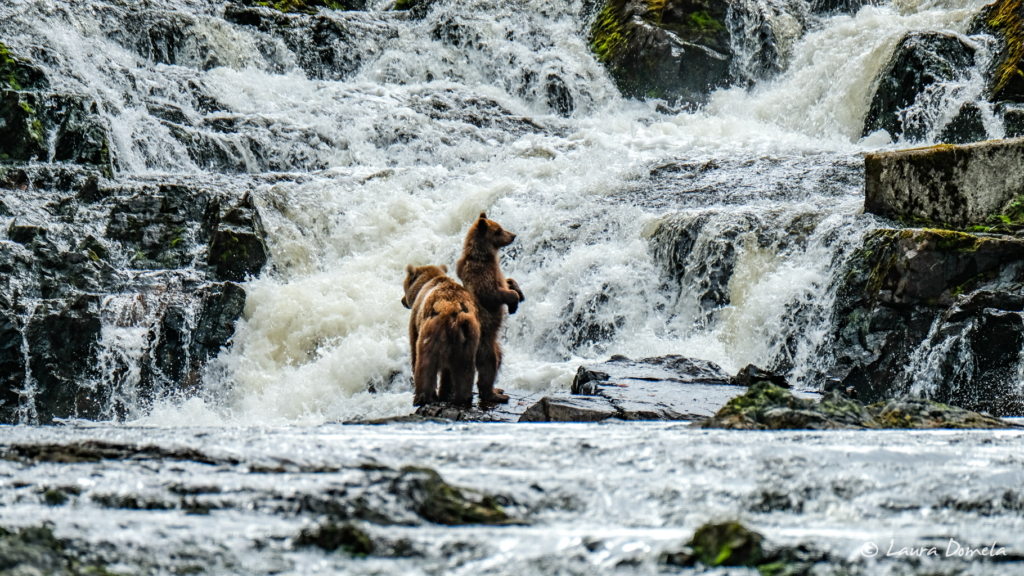
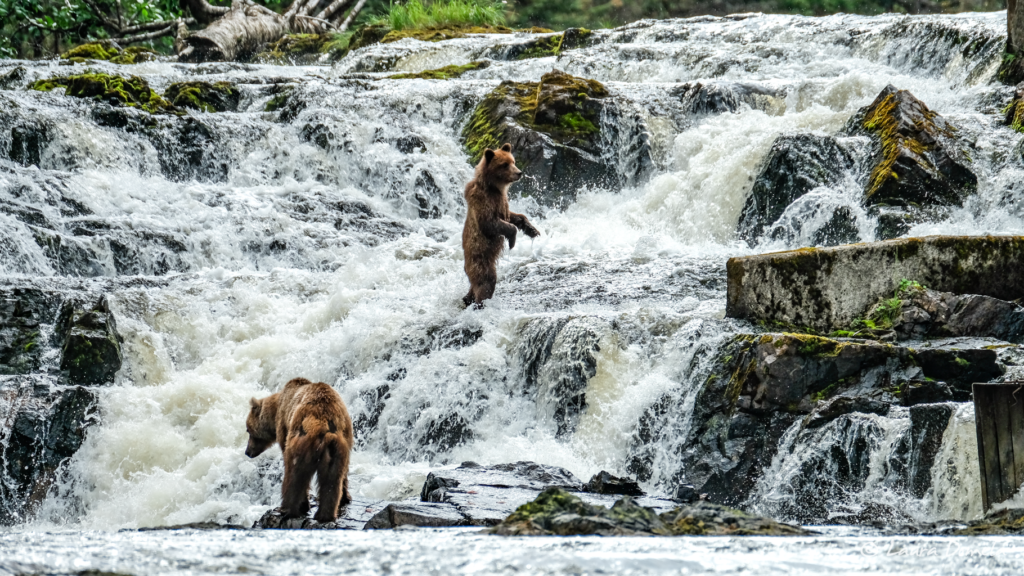
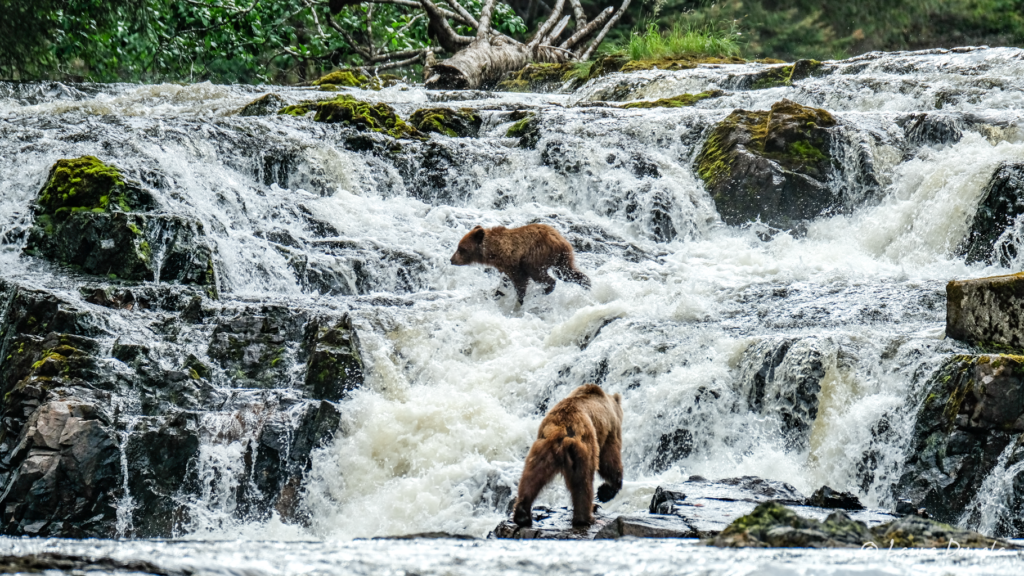
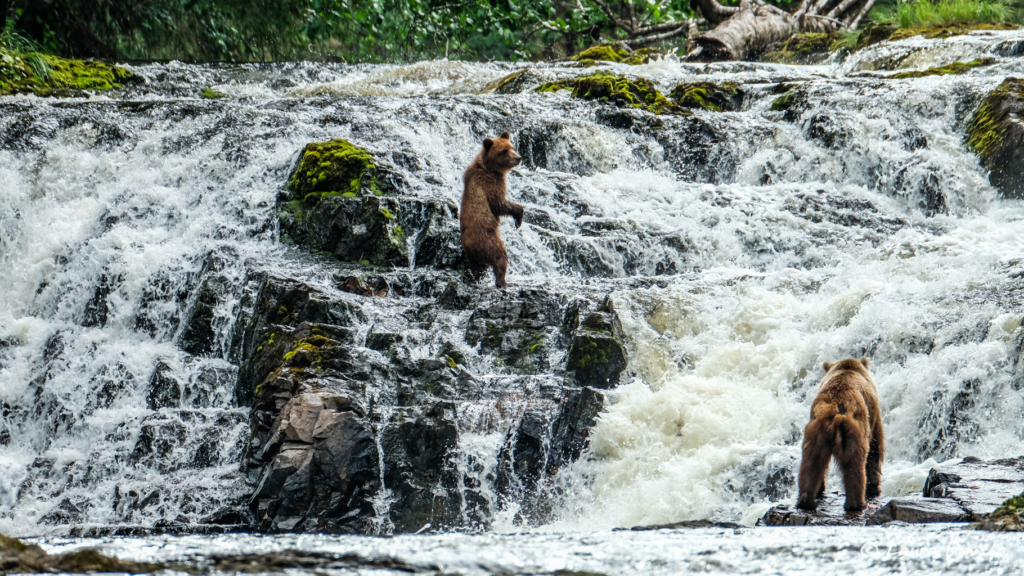
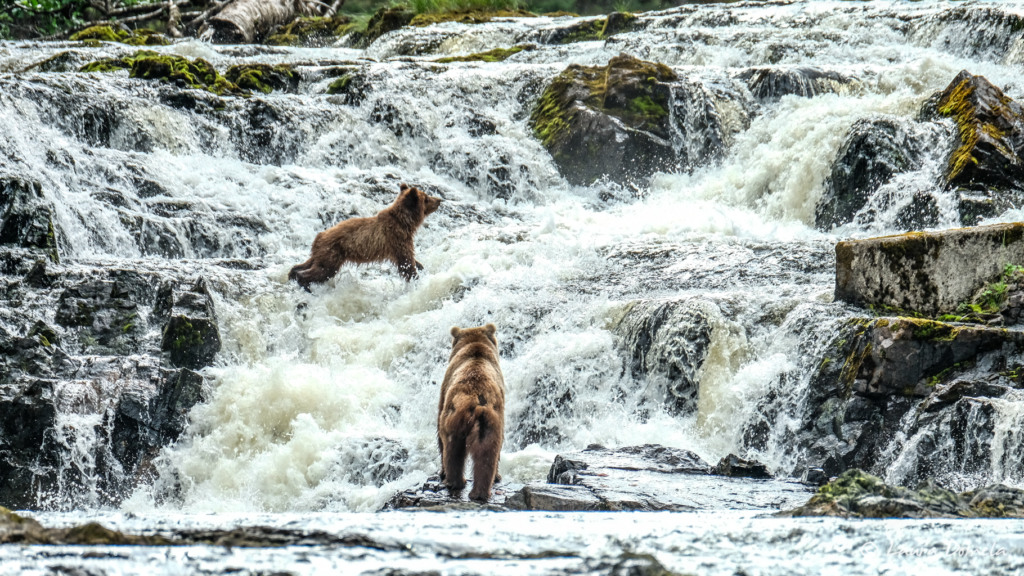
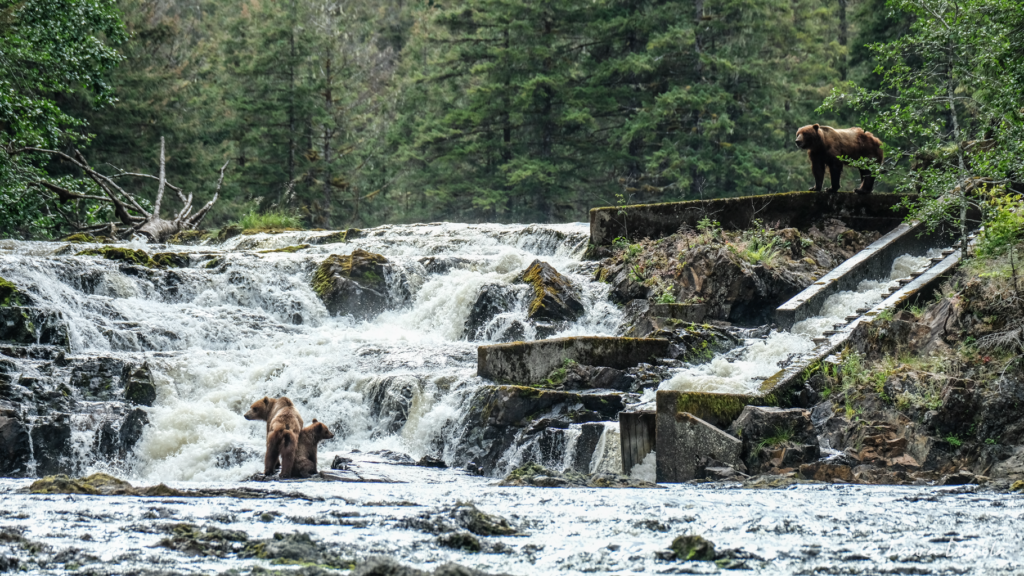
The male bear stood watch at the top of the fish ladder for some time…I got the feeling he and the sow had perhaps tangled in the past and he was waiting until they finished fishing for his turn in the stream. He eventually wandered off into the woods and the sow went back to the falls to fish, leaving baby surprisingly far behind. The cub was okay for a few minutes, but as he realized how far he was from mama he became visibly stressed at started making little bark/cry sounds as he shuffled up into the woods and hid behind a rock. Eventually, mama returned and the cub ran hard for her. So much fun getting to see all this bear behavior!
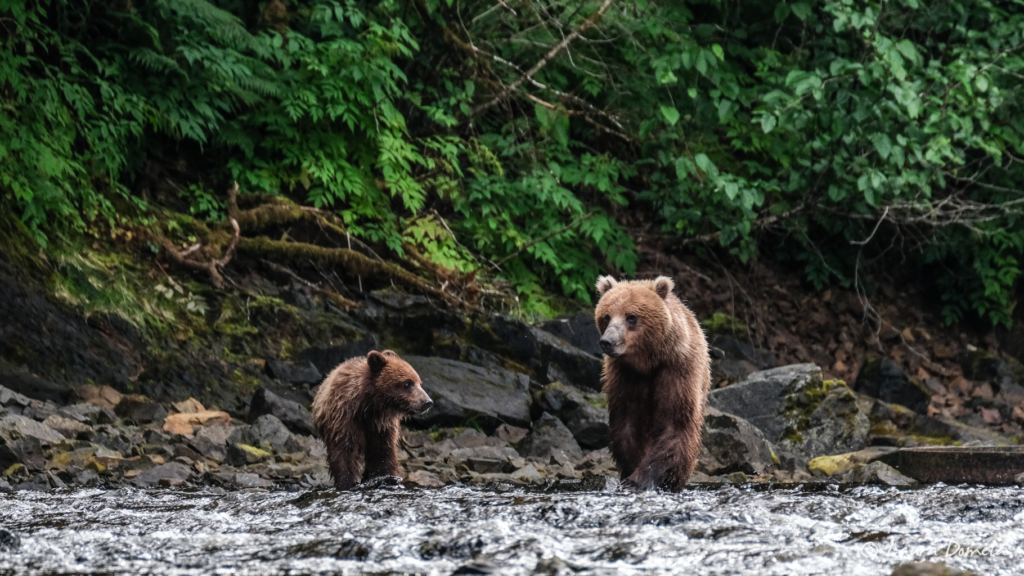
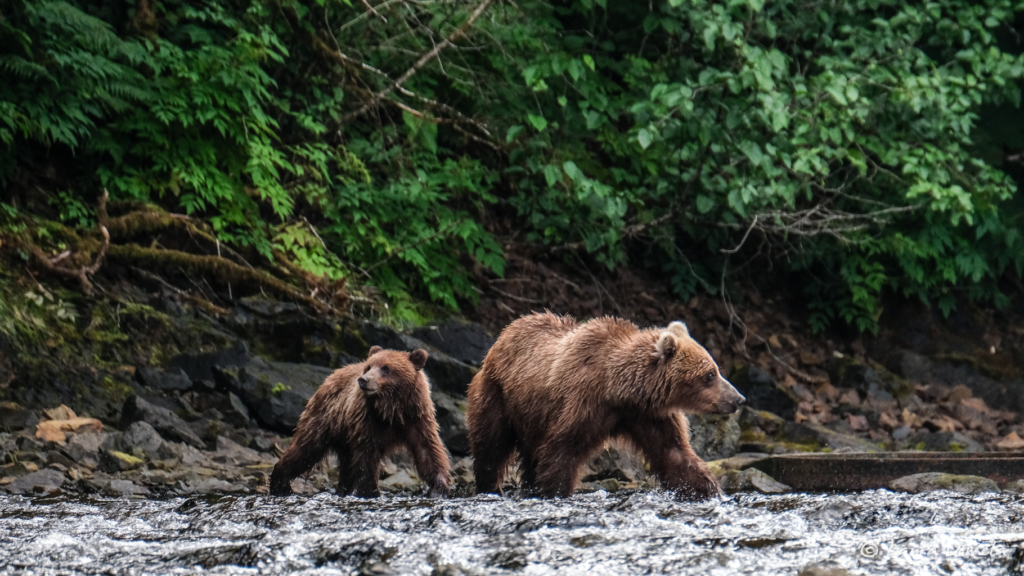
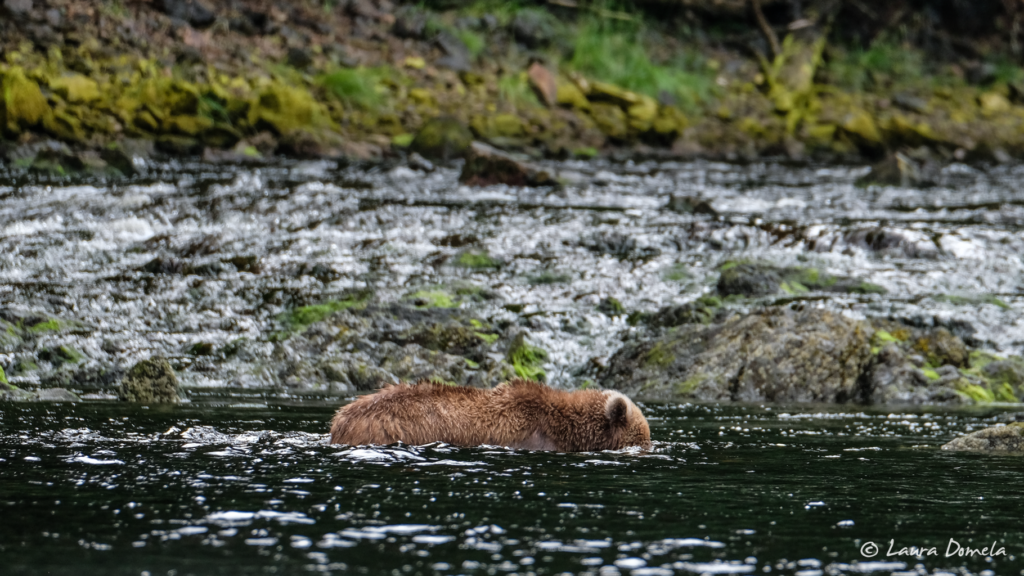
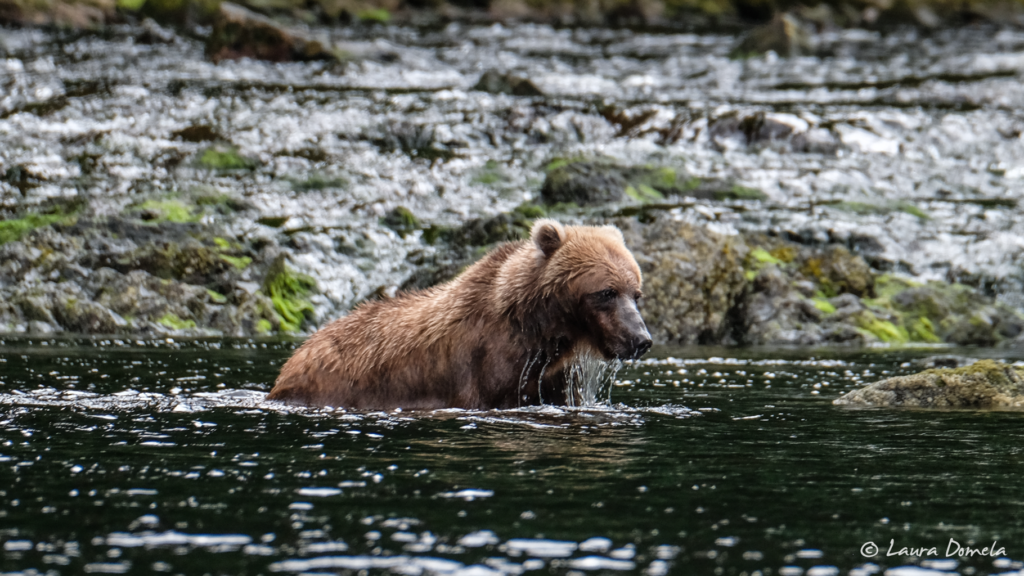
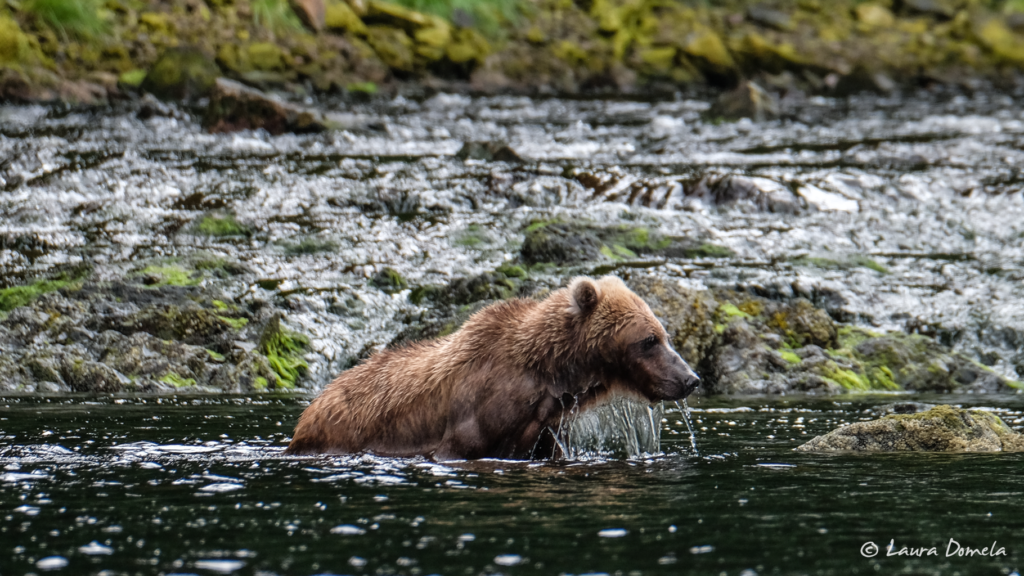
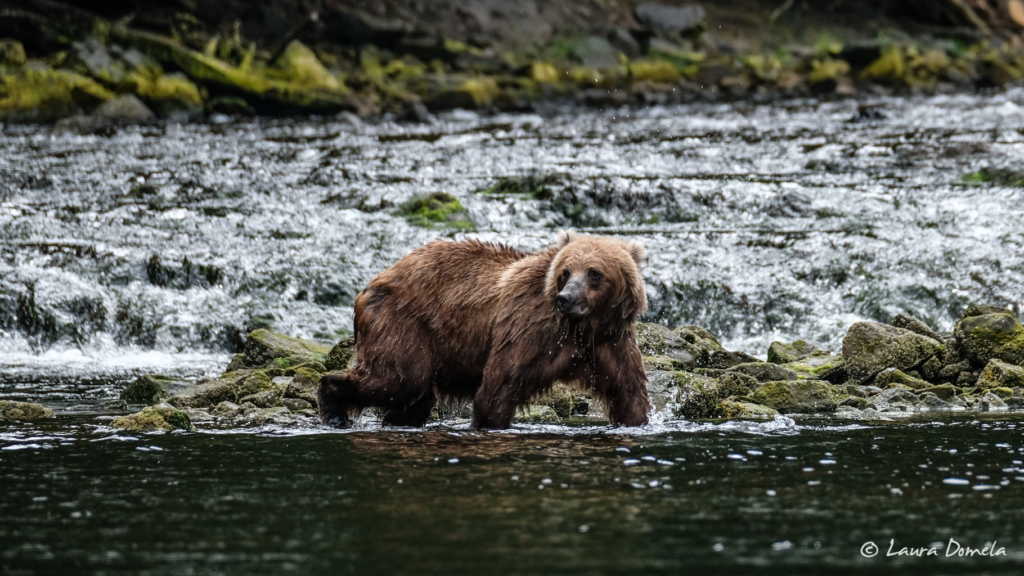
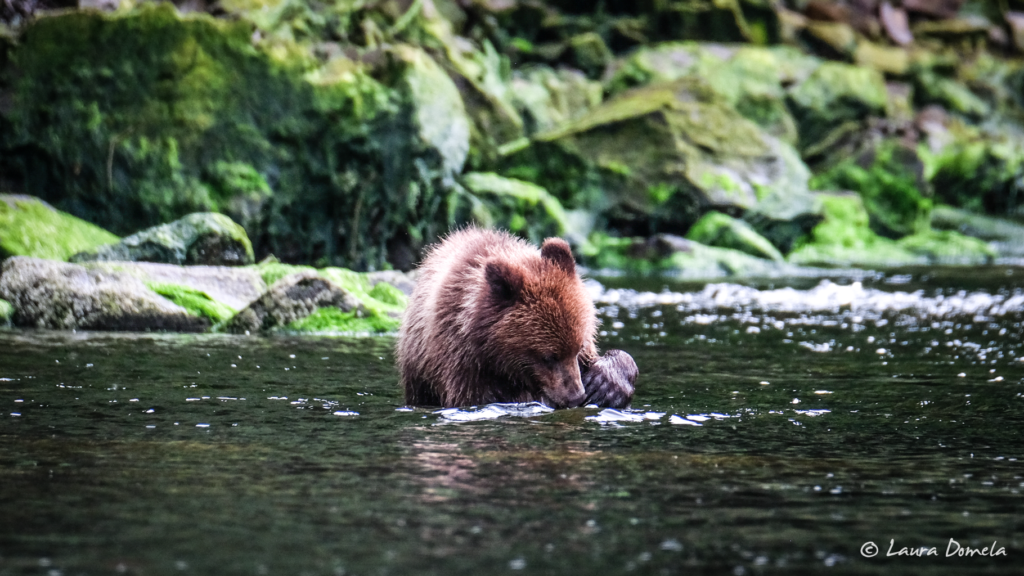
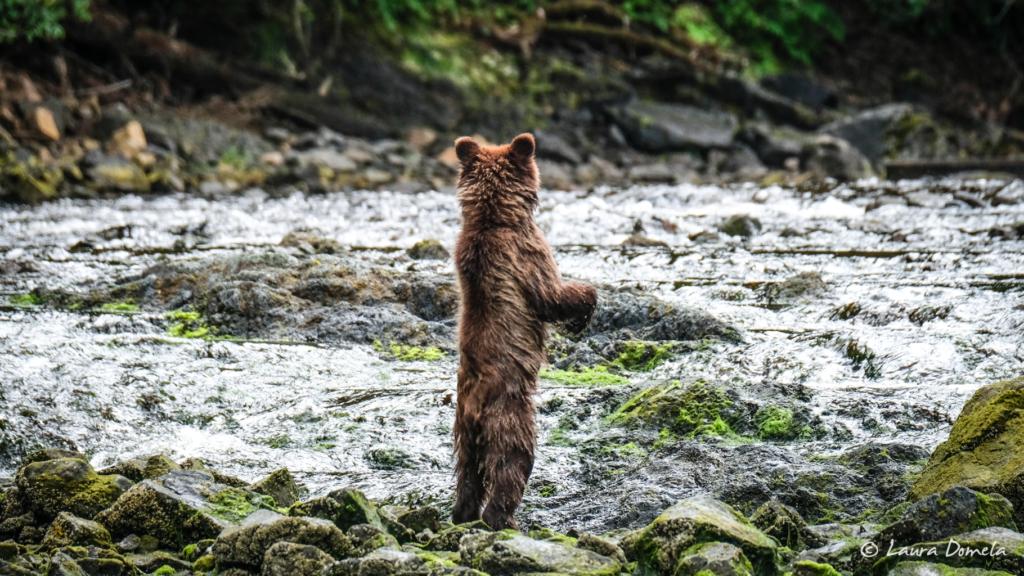
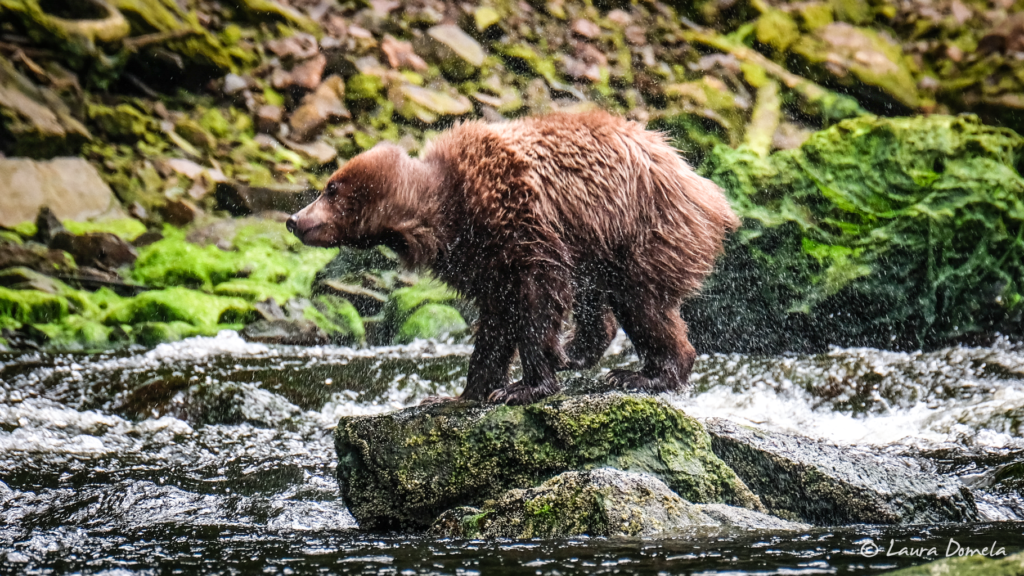
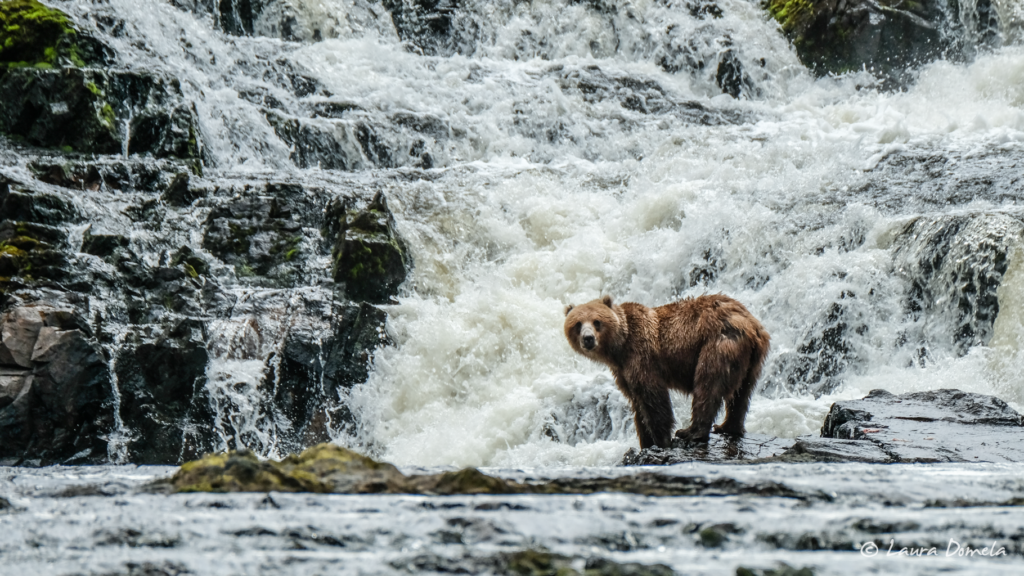
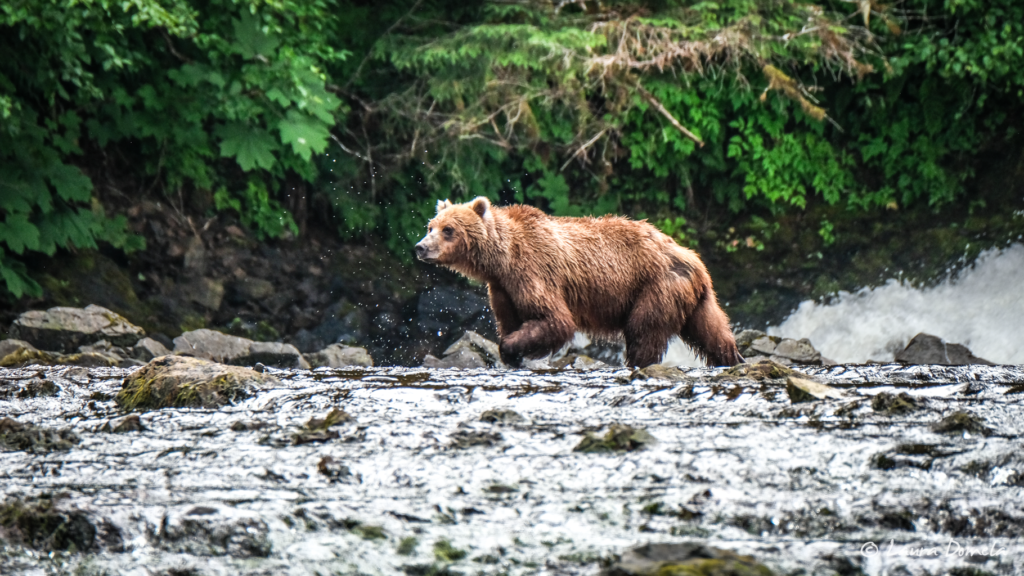
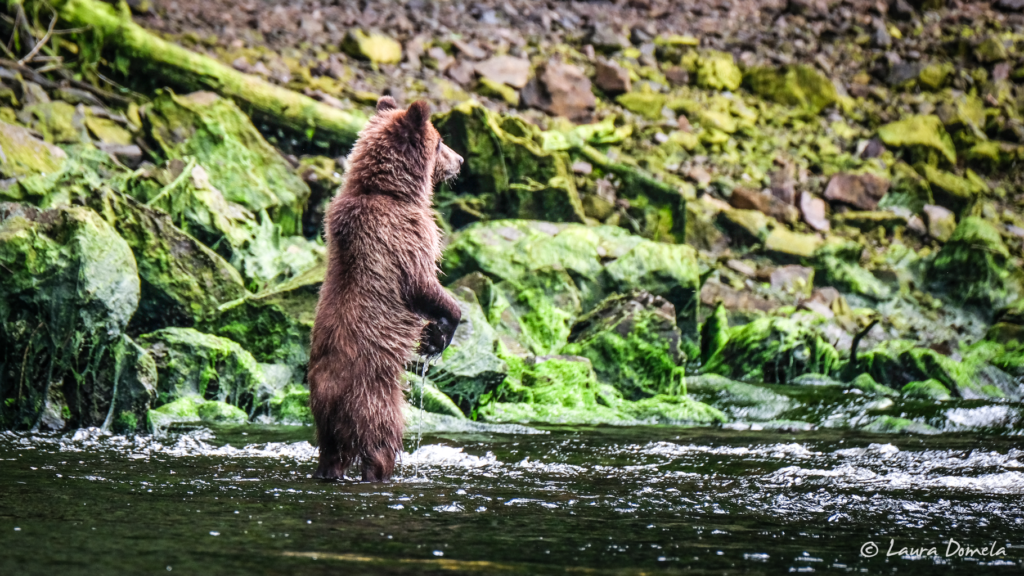
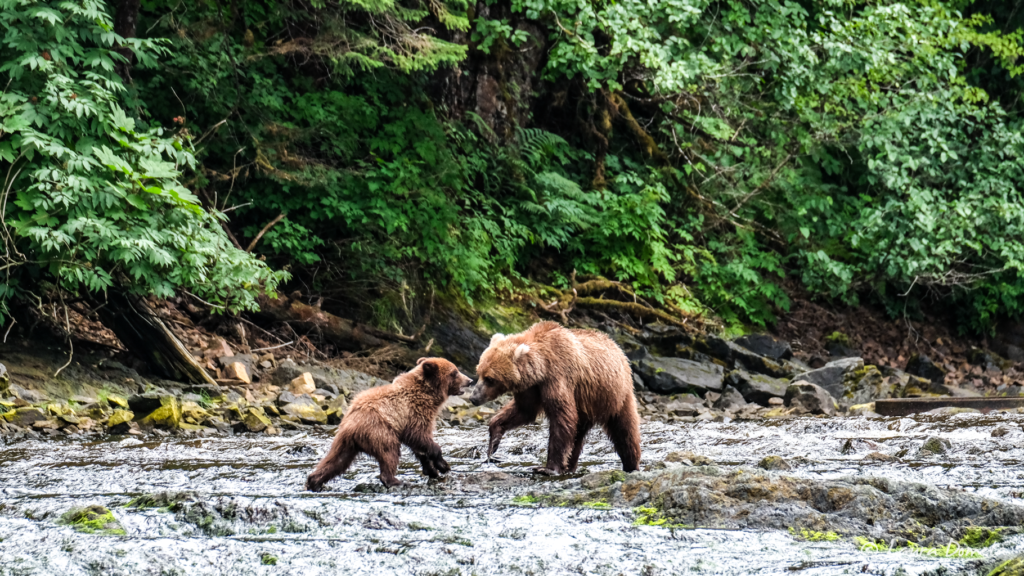
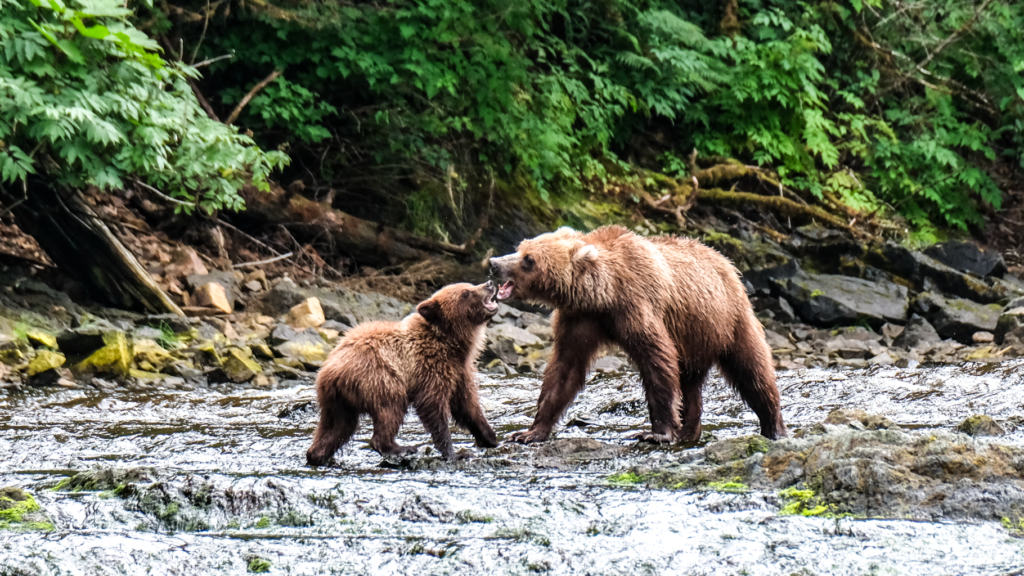
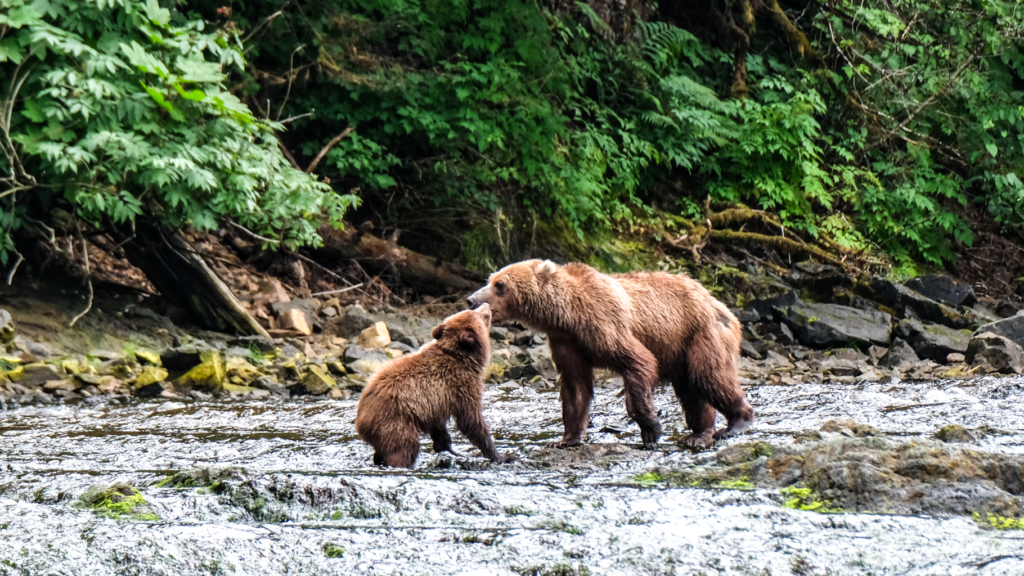
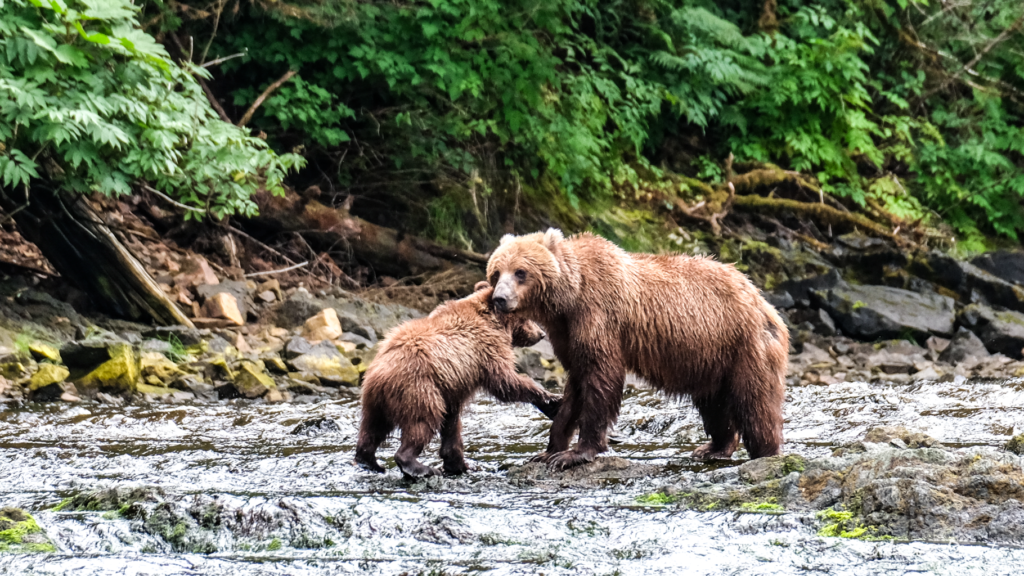
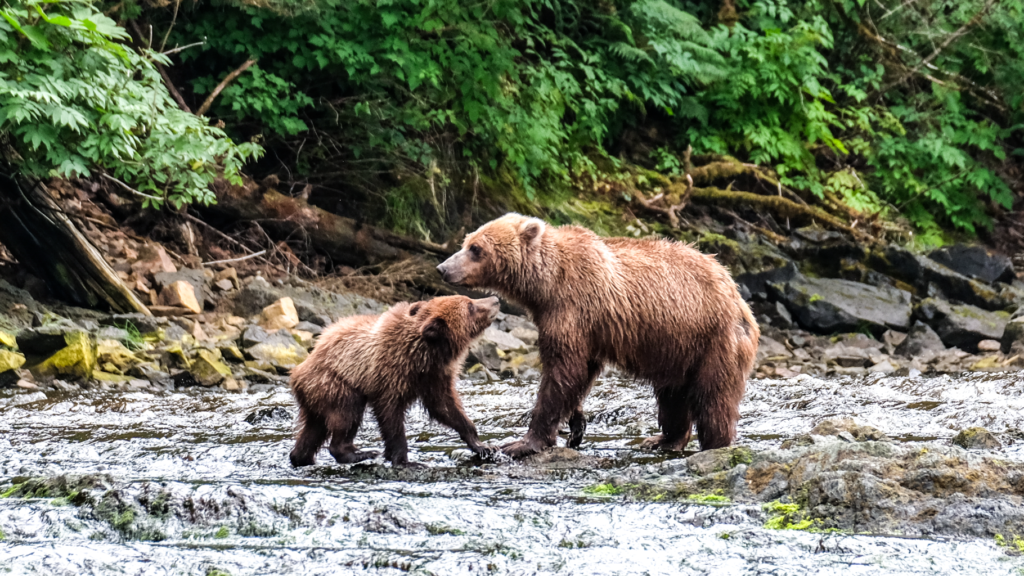
In the morning we pulled our two crab traps and one had five females in it. The other trap had two females and one good sized male. So…one crab for us! Those fresh fish heads were apparently good bait!
We left Pavlof Harbor and turned south in Chatham Strait. It was gray and rainy again, as expected. The forecast was for 15kt wind and 3ft waves, but the waves were more like 4-5ft and made for a bumpy ride. However, we had a great show from a humpback breaching over and over just off of East Point, and even with all the bumps, I managed a few sharp photos.
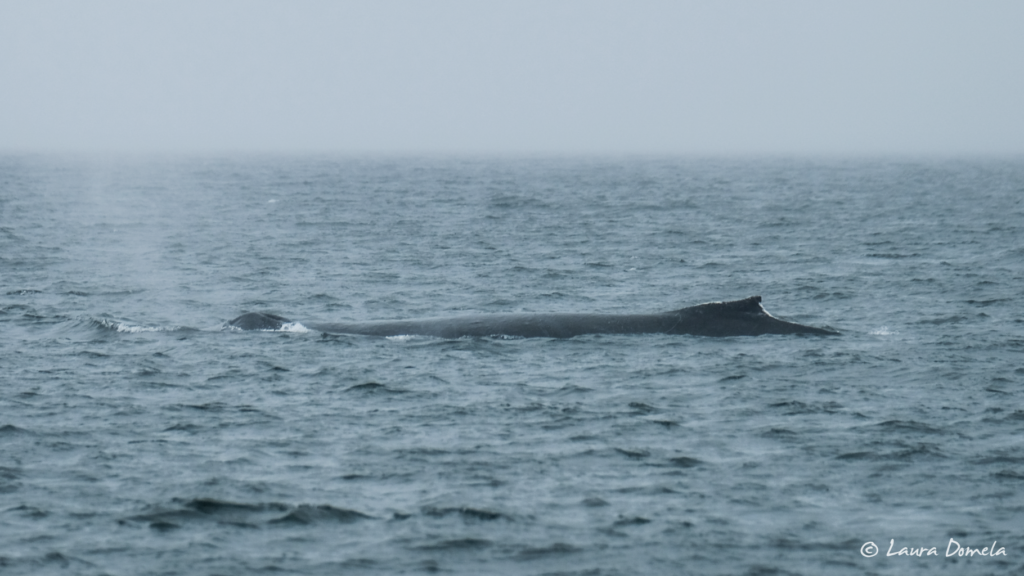
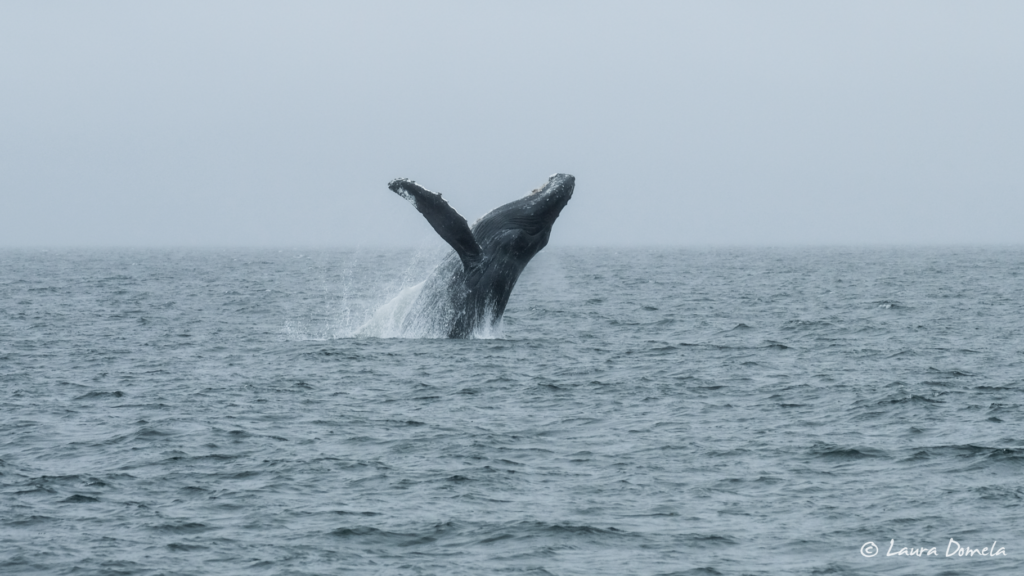
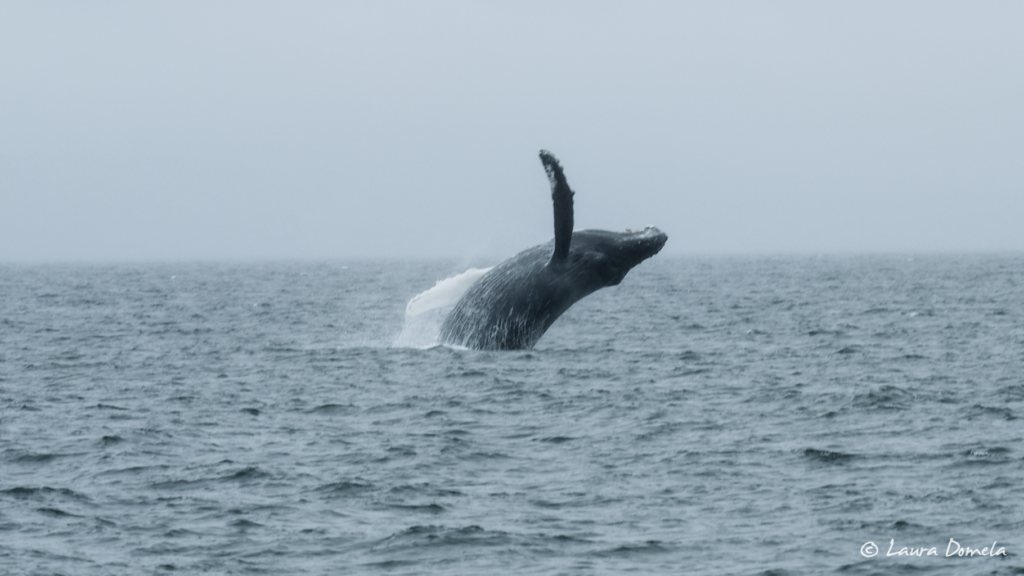
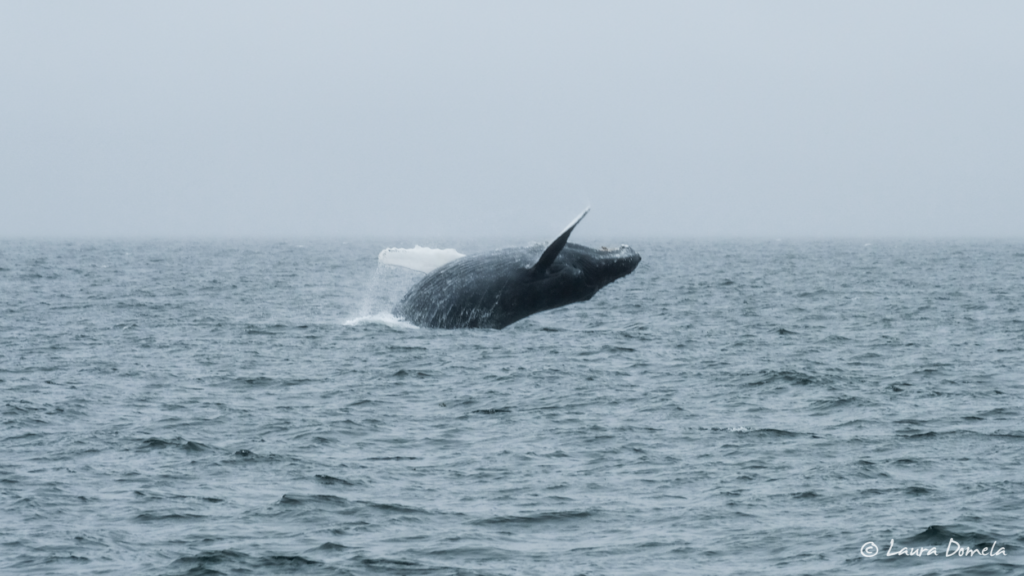
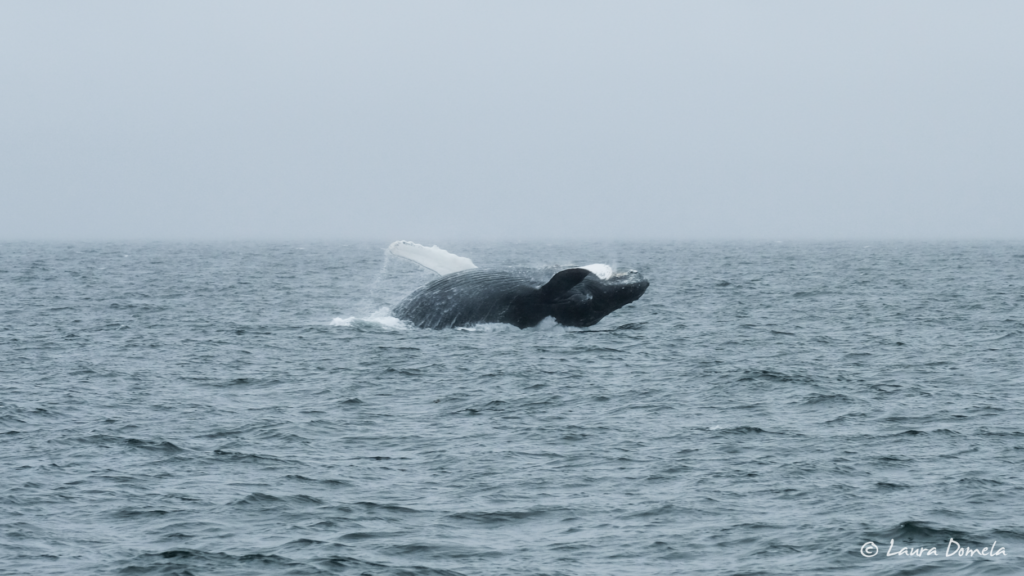
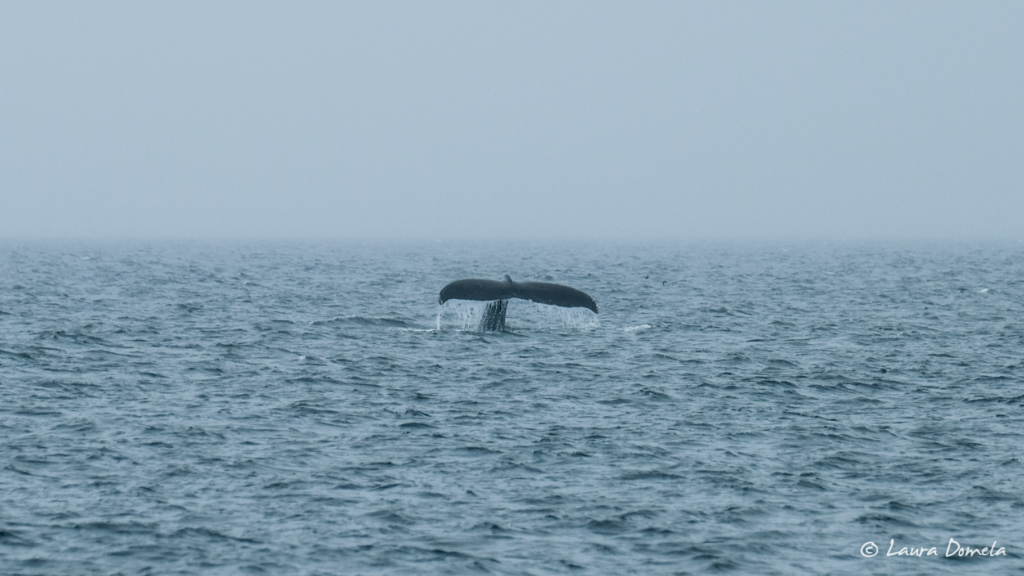
We continued into Peril Strait and eventually dropped anchor (and the two crab traps) in Appleton Cove. Normally there are a LOT of commercial traps in here and strangely, right now there are none. In the morning we pulled the traps before leaving and had one very large male…the meatiest one yet!
Before leaving Appleton, when we checked slack at Sergius, it was 12:40pm, which caused us to change our original plan of going into Baby Bear Bay to going all the way to a new anchorage in the Magoun Islands. We’d heard earlier in the morning while still in bed the Coast Guard trying to get information about a 40ft hand troller on the rocks at Zeal Point. We could only hear the Coast Guard side of the conversation, due to the distance, but we managed to glean that the single operator of the vessel was okay and there were several boats there helping out. Zeal Point is at the north end of Neva Strait, and today’s course would take us right past. By the time we were nearby by we could hear the VHF back forth about what they were doing to try to get the boat (the Chief Joseph) off the rocks. Sounded like there was no hull breach, but water flooded the cockpit and engine room. They had a crash pump and were about to start trying to dewater the vessel and hoped to get it floating again. We don’t yet know if they were successful, but perhaps when we get into Sitka we’ll hear the outcome.
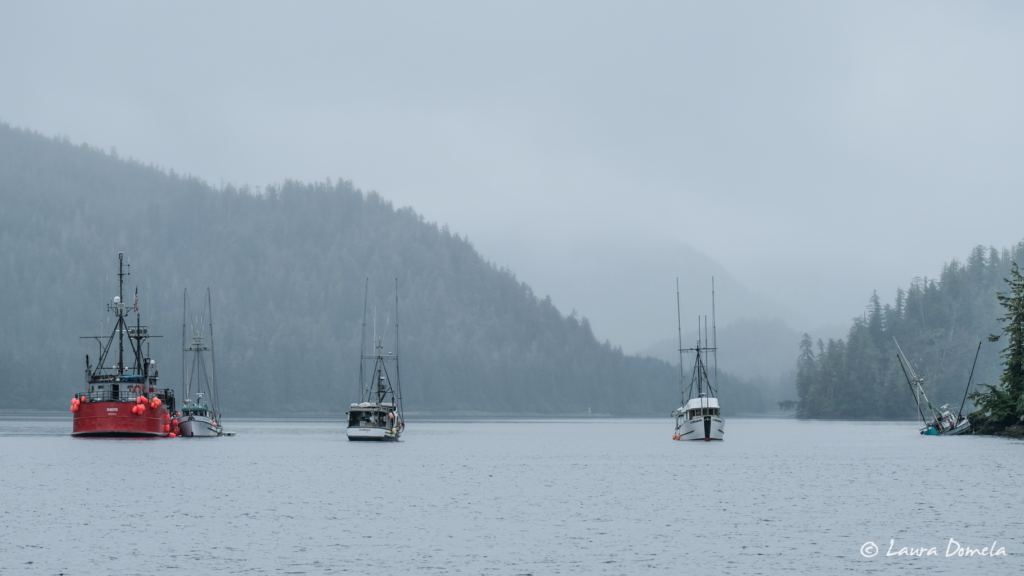
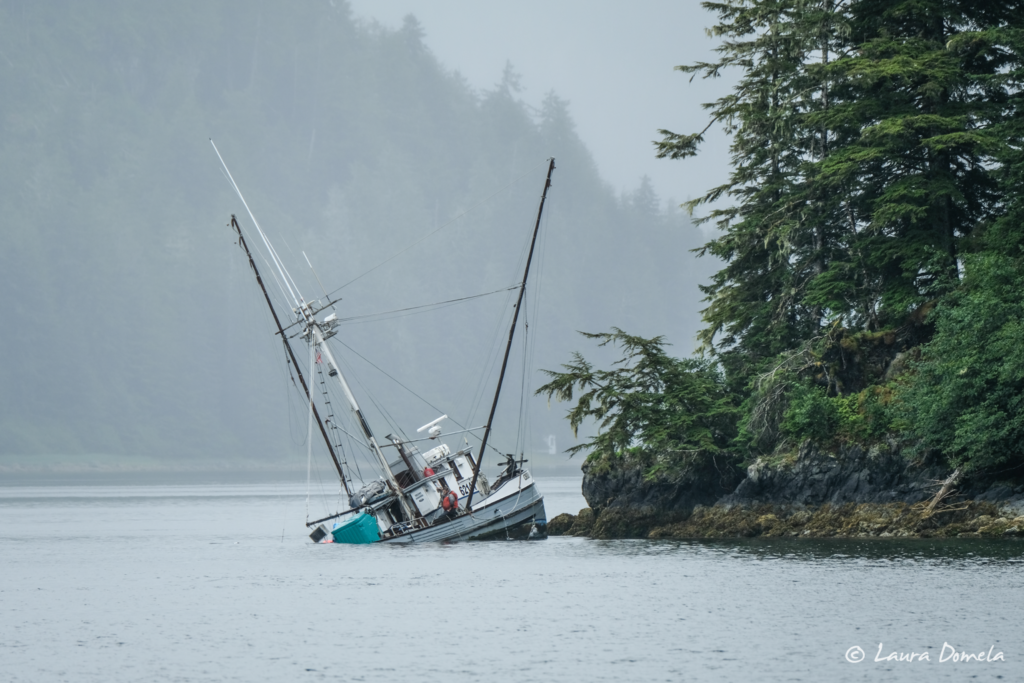
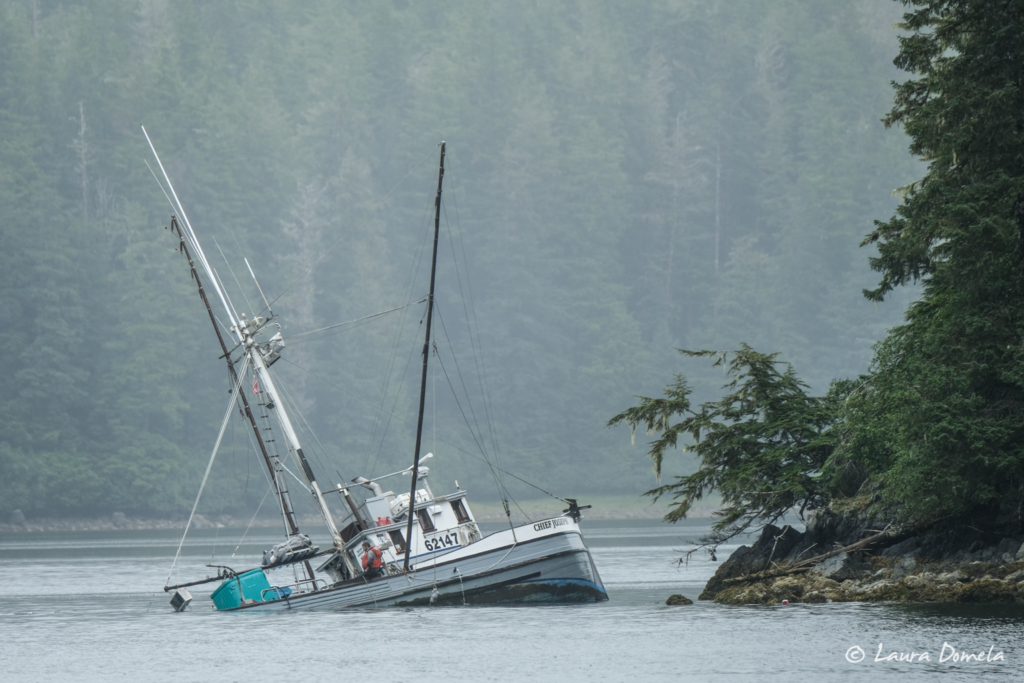
We turned off after Neva Strait and into Krestof Sound, taking the East Channel down and around the Magoun Islands and into a cove open to the south.
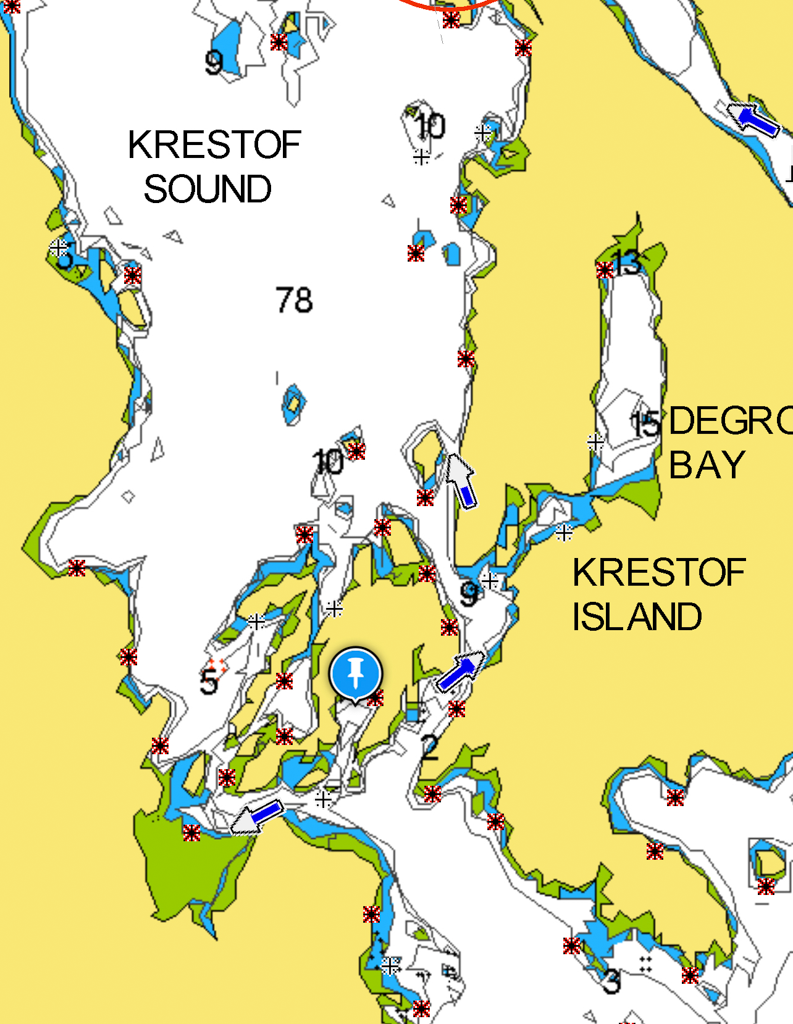
The anchorage was silent but for the distant cries of eagles and other little marine birds. The weather remained gray and rainy as we dropped our anchor in 40 feet or so. Soon there was a break in the rain so we took the dinghy out for some exploring.
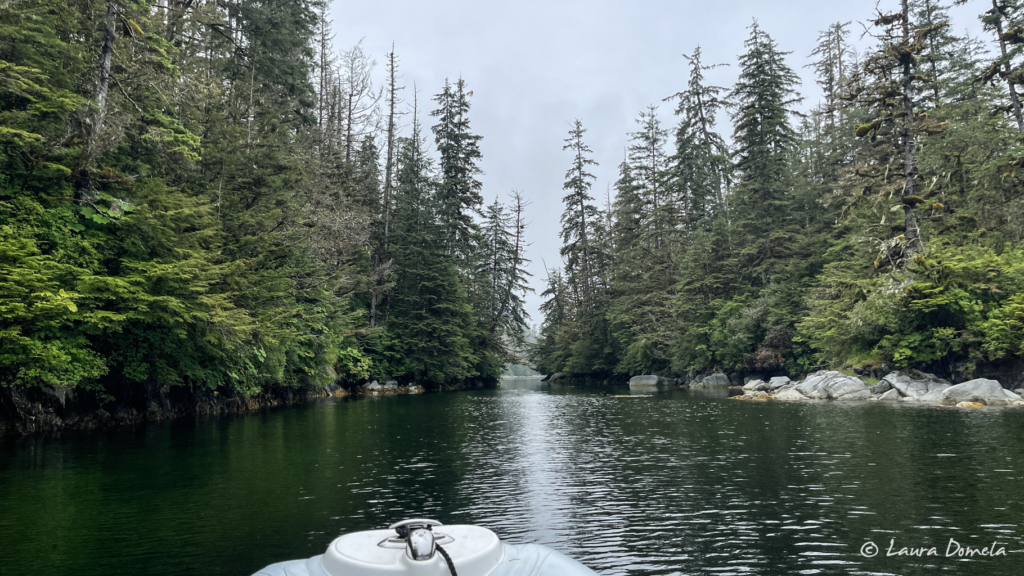
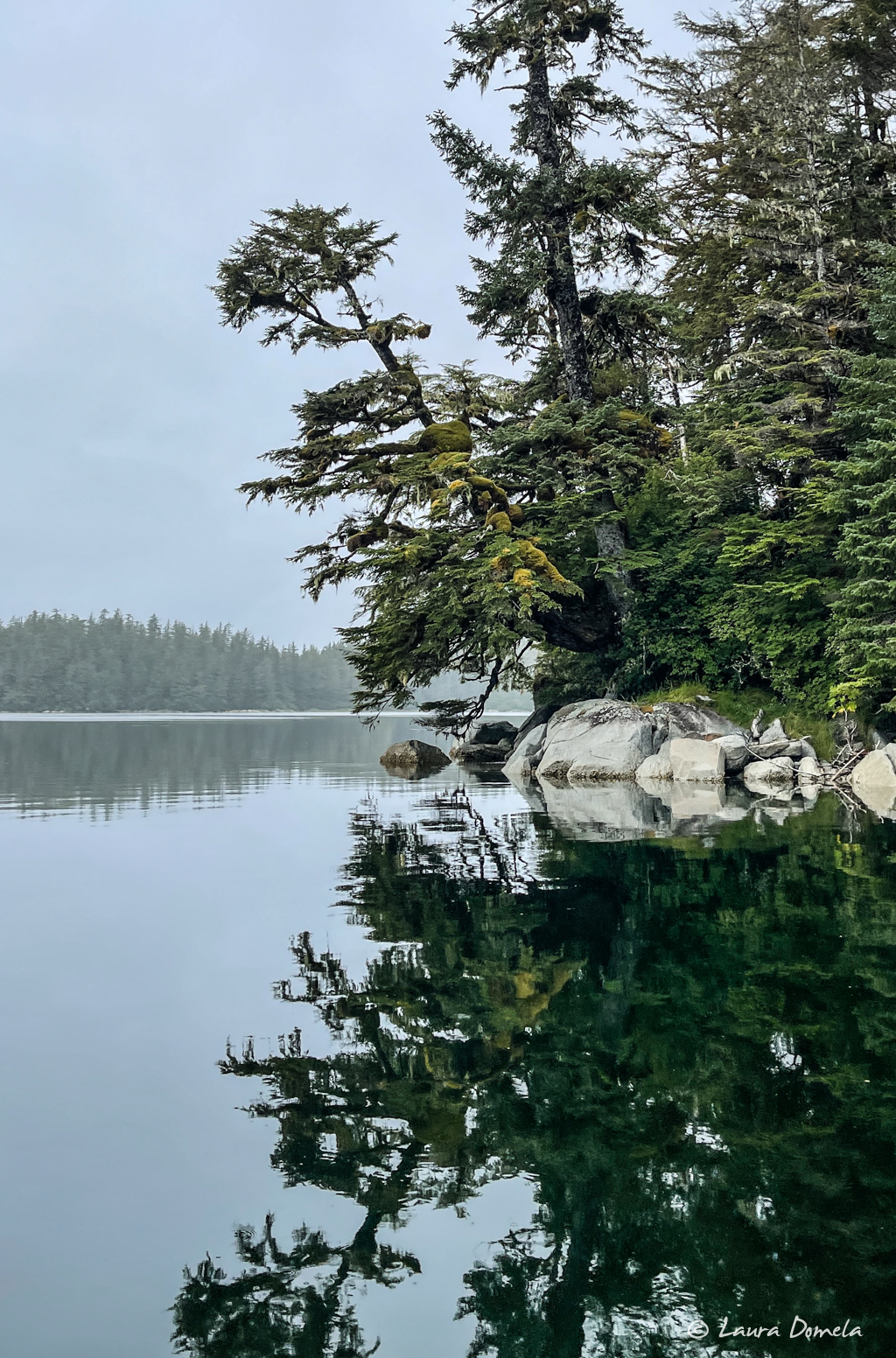
We made our way through little cuts between islands that were dry at lower tides, and then went around the corner to check out DeGroff Bay. This anchorage has a couple of great reviews, but after we made our way through the first and second entrances (which weren’t as nail-biting as it looks on the chart) we concluded that it’s not all that great of an anchorage (and we liked where we chose much better). To be fair, maybe when the gray fog lifts off of the mountains the view becomes a player in the ratings. On a day like today though, not worth any extra hassle.
We didn’t take too many photos here, but it’s a quiet, lovely anchorage.
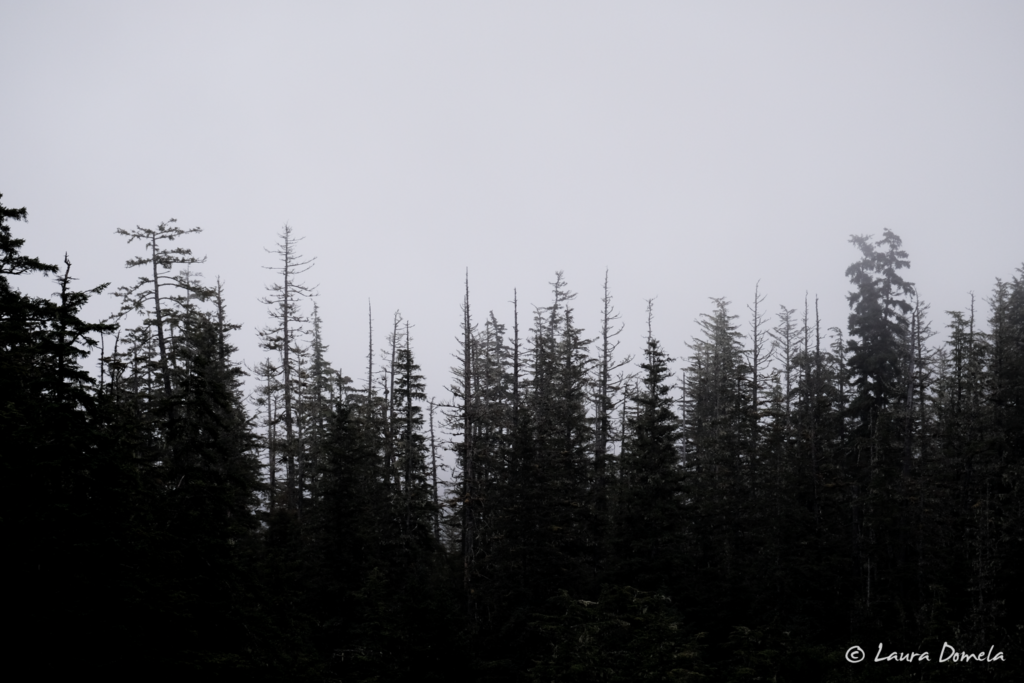
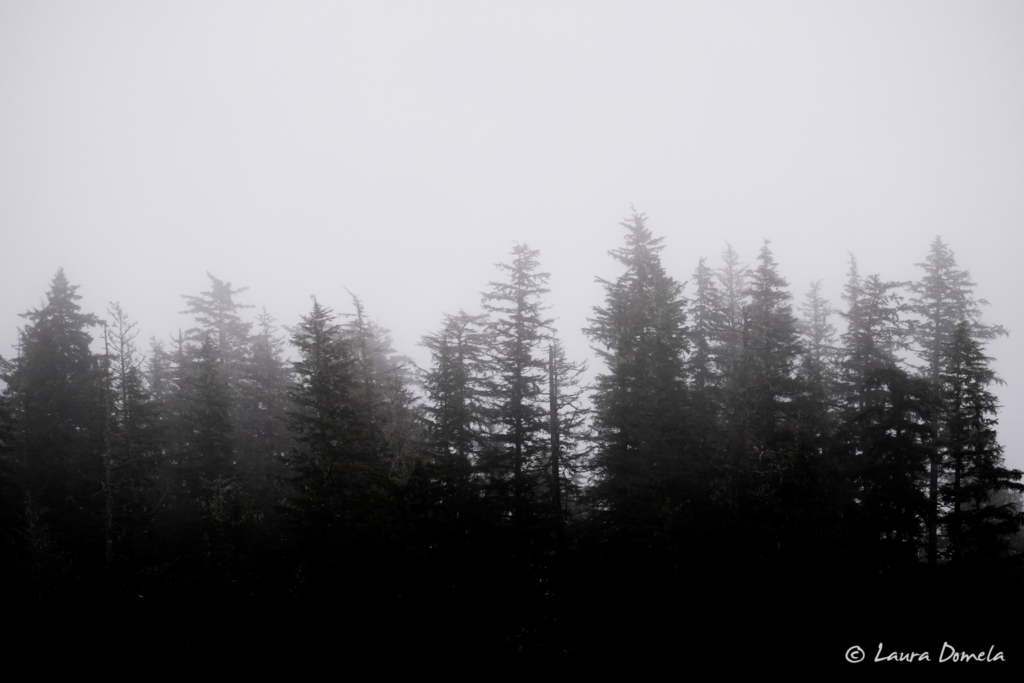
We were thinking we’d stay for a couple days, but changed our minds and opted to go see another new anchorage (Samsing Cove) on the other side of Sitka Sound. It was so calm out — why not? We ended up picking our way through at least 30 trolling boats (which wasn’t as hard as it seemed like it would be looking at our radar overlay). Visibility wasn’t great, but it was definitely good enough.
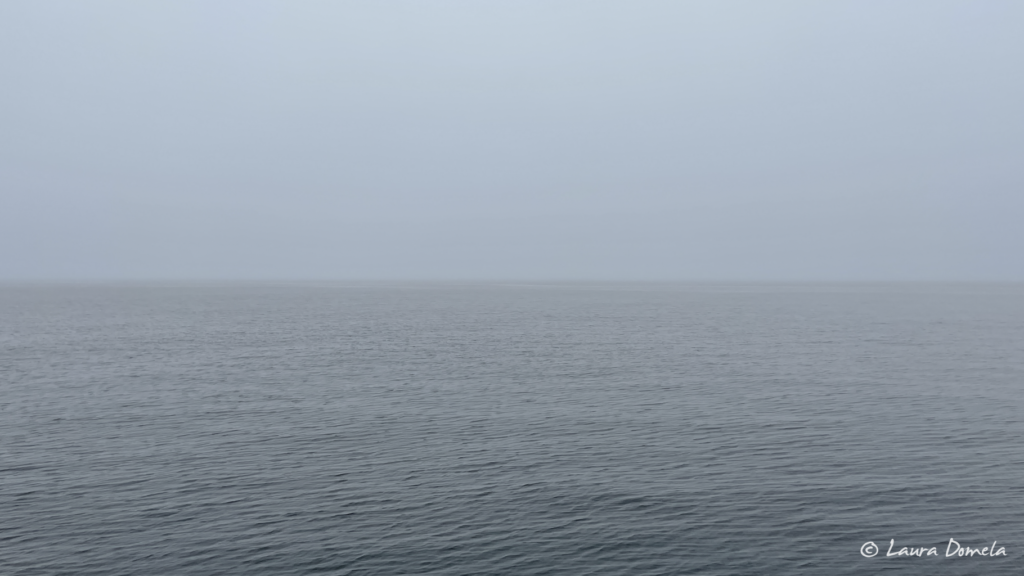
Here we are deviating from our course to make our way through/around all the fishing boats (red blobs on radar, not one with AIS):
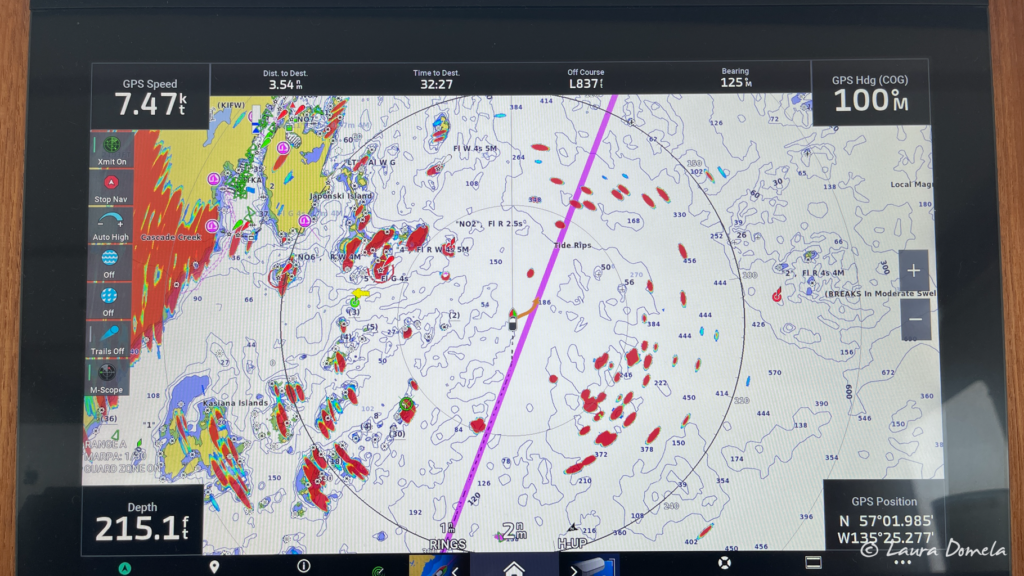
It wasn’t as tough in person as it looked like it could be on radar:
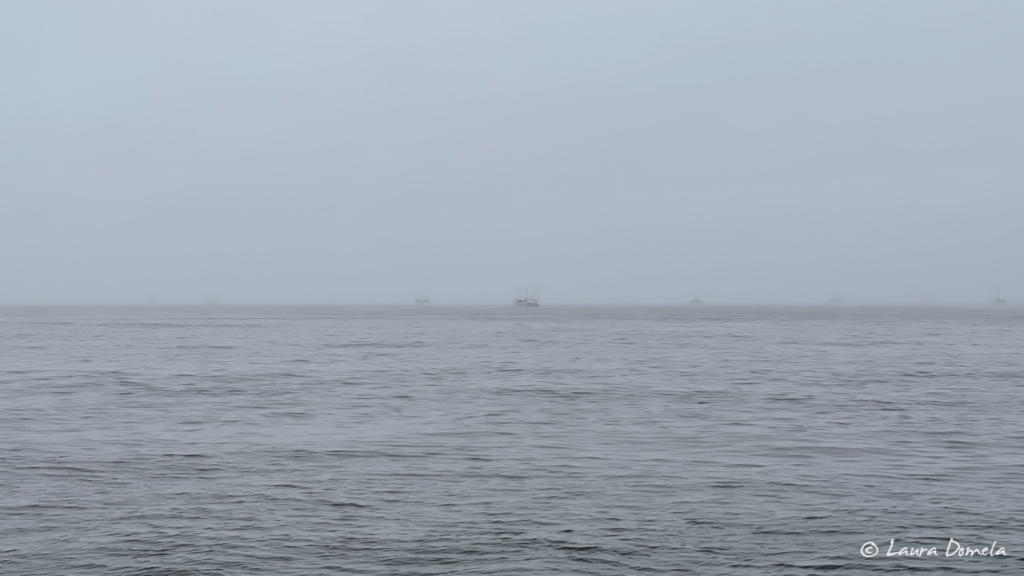
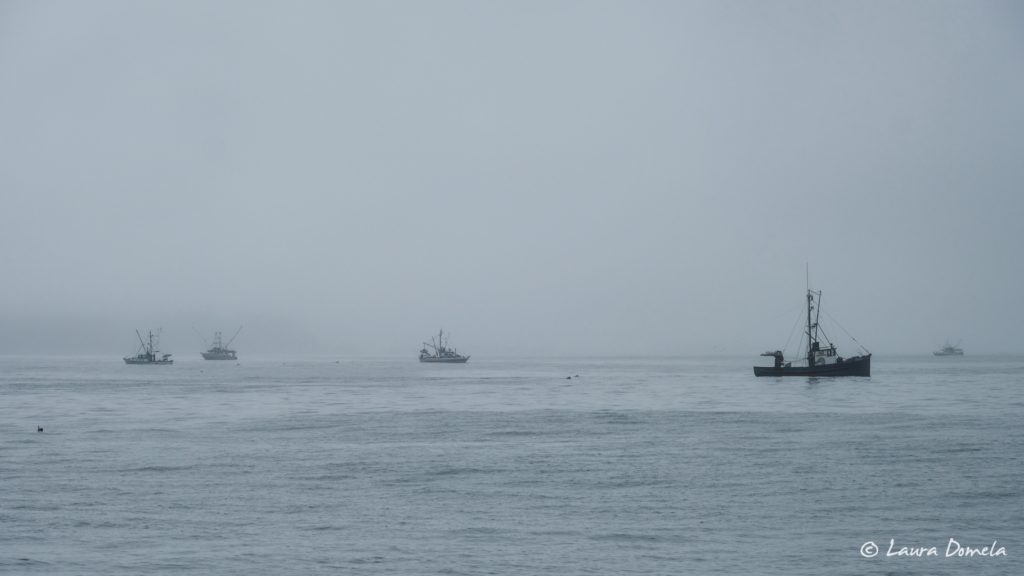
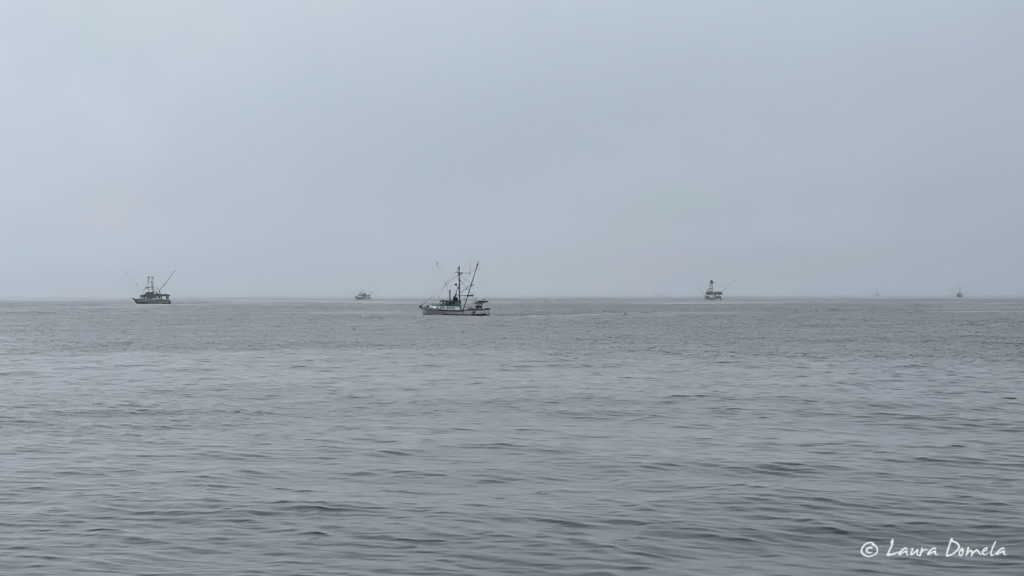
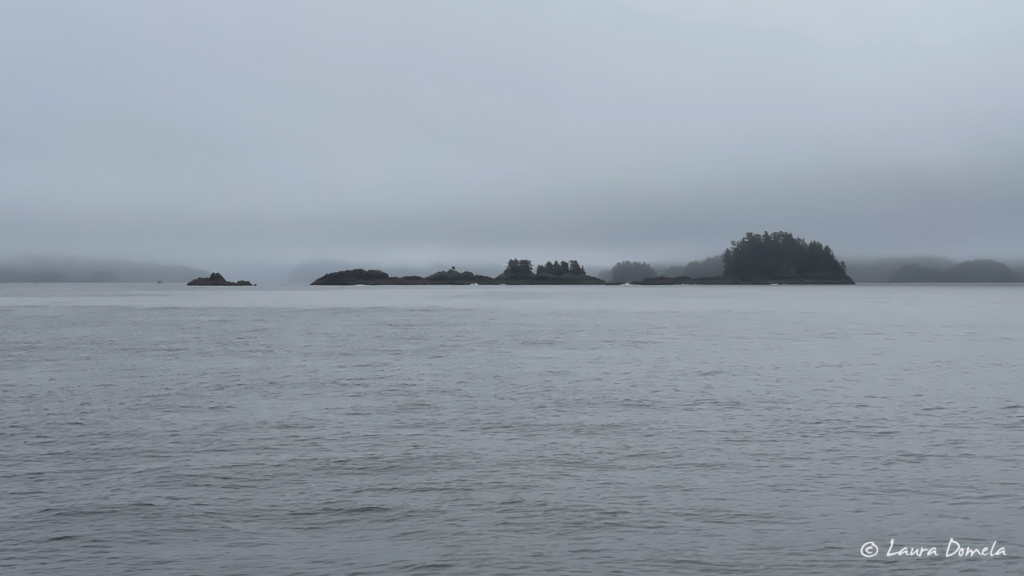
We pulled into Samsing Cove and anchored in 40 feet. It’s still gray and rainy. We’re only 6nm or so from Sitka, where we’ll pick up Kevin’s brother on Wednesday, so we’ll just enjoy our time out here and then maybe take the long way tomorrow or Monday. Not sure where we’ll go next, actually…maybe south, maybe north. We’ll make a call based on weather when we get closer, but for now we have three solid plans!

